1. nginx简介
nginx(发音同engine x)是一款轻量级的Web服务器/反向代理服务器及电子邮件(IMAP/POP3)代理服务器,并在一个BSD-like协议下发行。
nginx由俄罗斯的程序设计师Igor Sysoev所开发,最初供俄国大型的入口网站及搜寻引擎Rambler使用。
第一个公开版本0.1.0发布于2004年10月4日。其将源代码以类BSD许可证的形式发布,因它的稳定性、丰富的功能集、示例配置文件和低系统资源的消耗而闻名。2011年6月1日,nginx 1.0.4发布。
nginx的特点是占有内存少,并发能力强,事实上nginx的并发能力确实在同类型的网页服务器中表现较好,中国大陆使用nginx网站用户有:百度、京东、新浪、网易、腾讯、淘宝等。
2. nginx的特性与优点
2.1 nginx的特性
nginx是一个很牛的高性能Web和反向代理服务器,它具有很多非常优越的特性:
- 在高连接并发的情况下,nginx是Apache服务器不错的替代品,能够支持高达50000个并发连接数的响应
- 使用epoll and kqueue作为开发模型
- nginx作为负载均衡服务器:nginx既可在内部直接支持和PHP程序对外进行服务,也可支持作为HTTP代理服务器对外进行服务
- nginx采用C进行编写,不论系统资源开销还是CPU使用效率都比Perlbal要好很多
2.2 nginx的优点
- 高并发连接:官方测试能够支撑5万并发连接,在实际生产环境中跑到2-3万并发连接数
- 内存消耗少:在3万并发连接下,开启的10个nginx进程才消耗150M内存(15M*10=150M)
- 配置文件非常简单:风格跟程序一样通俗易懂
- 成本低廉:nginx为开源软件,可以免费使用。而购买F5 BIG-IP、NetScaler等硬件负载均衡交换机则需要十多万至几十万人民币
- 支持Rewrite重写规则:能够根据域名、URL的不同,将HTTP请求分到不同的后端服务器群组
- 内置的健康检查功能:如果Nginx Proxy后端的某台Web服务器宕机了,不会影响前端访问
- 节省带宽:支持GZIP压缩,可以添加浏览器本地缓存的Header头
- 稳定性高:用于反向代理,宕机的概率微乎其微
- 模块化设计:模块可以动态编译
- 外围支持好:文档全,二次开发和模块较多
- 支持热部署:可以不停机重载配置文件
- 支持事件驱动、AIO(AsyncIO,异步IO)、mmap(Memory Map,内存映射)等性能优化
3. nginx的功能及应用类别
3.1 nginx的基本功能
- 静态资源的web服务器,能缓存打开的文件描述符
- http、smtp、pop3协议的反向代理服务器
- 缓存加速、负载均衡
- 支持FastCGI(fpm,LNMP),uWSGI(Python)等
- 模块化(非DSO机制),过滤器zip、SSI及图像的大小调整
- 支持SSL
3.2 nginx的扩展功能
- 基于名称和IP的虚拟主机
- 支持keepalive
- 支持平滑升级
- 定制访问日志、支持使用日志缓冲区提高日志存储性能
- 支持URL重写
- 支持路径别名
- 支持基于IP及用户的访问控制
- 支持速率限制,支持并发数限制
3.3 nginx的应用类别
- 使用nginx结合FastCGI运行PHP、JSP、Perl等程序
- 使用nginx作反向代理、负载均衡、规则过滤
- 使用nginx运行静态HTML网页、图片
- nginx与其他新技术的结合应用
4. nginx的模块与工作原理
nginx由内核和模块组成。其中,内核的设计非常微小和简洁,完成的工作也非常简单,仅仅通过查找配置文件将客户端请求映射到一个location block(location是nginx配置中的一个指令,用于URL匹配),而在这个location中所配置的每个指令将会启动不同的模块去完成相应的工作。
4.1 nginx的模块分类
nginx的模块从结构上分为核心模块、基础模块和第三方模块
- HTTP模块、EVENT模块和MAIL模块等属于核心模块
- HTTP Access模块、HTTP FastCGI模块、HTTP Proxy模块和HTTP Rewrite模块属于基本模块
- HTTP Upstream模块、Request Hash模块、Notice模块和HTTP Access Key模块属于第三方模块
用户根据自己的需要开发的模块都属于第三方模块。正是有了如此多模块的支撑,nginx的功能才会如此强大
nginx模块从功能上分为三类,分别是:
- Handlers(处理器模块)。此类模块直接处理请求,并进行输出内容和修改headers信息等操作。handlers处理器模块一般只能有一个
- Filters(过滤器模块)。此类模块主要对其他处理器模块输出的内容进行修改操作,最后由nginx输出
- Proxies(代理器模块)。就是nginx的HTTP Upstream之类的模块,这些模块主要与后端一些服务比如fastcgi等操作交互,实现服务代理和负载均衡等功能
nginx模块分为:核心模块、事件模块、标准Http模块、可选Http模块、邮件模块、第三方模块和补丁等
- nginx基本模块:所谓基本模块,指的是nginx默认的功能模块,它们提供的指令,允许你使用定义nginx基本功能的变量,在编译时不能被禁用,包括:
- 核心模块:基本功能和指令,如进程管理和安全。常见的核心模块指令,大部分是放置在配置文件的顶部
- 事件模块:在Nginx内配置网络使用的能力。常见的events(事件)模块指令,大部分是放置在配置文件的顶部
- 配置模块:提供包含机制
具体的指令,请参考nginx的官方文档
4.2 nginx的工作原理
nginx的模块直接被编译进nginx,因此属于静态编译方式。
启动nginx后,nginx的模块被自动加载,与Apache不一样,首先将模块编译为一个so文件,然后在配置文件中指定是否进行加载。
在解析配置文件时,nginx的每个模块都有可能去处理某个请求,但是同一个处理请求只能由一个模块来完成。
nginx的进程架构:
启动nginx时,会启动一个Master进程,这个进程不处理任何客户端的请求,主要用来产生worker线程,一个worker线程用来处理n个request。

下图展示了基本的WEB服务请求步骤

5. nginx的安装与配置
5.1 nginx的安装
//关闭防火墙和selinux子系统
[root@localhost ~]# systemctl stop firewalld.service
[root@localhost ~]# systemctl disable firewalld.service
[root@localhost ~]# sed -i s/SELINUX=enforcing/SELINUX=disabled/g /etc/selinux/config
[root@localhost ~]# setenforce 0
//创建系统用户nginx
[root@localhost ~]# useradd -r -M -s /sbin/nologin nginx
//安装依赖环境
[root@localhost ~]# yum -y install pcre-devel openssl openssl-devel gd-devel gcc gcc-c++ wget make
[root@localhost ~]# yum -y groups mark install 'Development Tools'
//创建日志存放目录
[root@localhost ~]# mkdir -p /var/log/nginx
[root@localhost ~]# chown -R nginx.nginx /var/log/nginx
//下载nginx
//nginx 官网 https://nginx.org/en/download.html
[root@localhost ~]# cd /usr/local/src/
[root@localhost ~]# wget https://nginx.org/download/nginx-1.20.2.tar.gz
//编译安装
[root@localhost src]# ls
nginx-1.20.2.tar.gz
[root@localhost src]# tar -xf nginx-1.20.2.tar.gz
[root@localhost src]# cd nginx-1.20.2/
[root@localhost nginx-1.20.2]# ./configure \
--prefix=/usr/local/nginx \
--user=nginx \
--group=nginx \
--with-debug \
--with-http_ssl_module \
--with-http_realip_module \
--with-http_image_filter_module \
--with-http_gunzip_module \
--with-http_gzip_static_module \
--with-http_stub_status_module \
--http-log-path=/var/log/nginx/access.log \
--error-log-path=/var/log/nginx/error.log
[root@localhost nginx-1.20.2]# make -j $(grep 'processor' /proc/cpuinfo | wc -l) && make install
5.2 nginx安装后配置
//配置环境变量
[root@localhost ~]# echo 'export PATH=/usr/local/nginx/sbin:$PATH' > /etc/profile.d/nginx.sh
[root@localhost ~]# . /etc/profile.d/nginx.sh
//服务控制方式,使用nginx命令
-t //检查配置文件语法
-v //输出nginx的版本
-c //指定配置文件的路径
-s //发送服务控制信号,可选值有{stop|quit|reopen|reload}
设置nginx 开机自启
[root@localhost ~]# cp /usr/lib/systemd/system/sshd.service /usr/lib/systemd/system/nginx.service
[root@localhost ~]# vim /usr/lib/systemd/system/nginx.service
[root@localhost ~]# cat /usr/lib/systemd/system/nginx.service
[Unit]
Description=nginx server daemon
After=network.target
[Service]
Type=forking
ExecStart=/usr/local/nginx/sbin/nginx
ExecStop=/usr/local/nginx/sbin/nginx -s stop
ExecReload=/bin/kill -HUP $MAINPID
[Install]
WantedBy=multi-user.target
[root@localhost ~]# systemctl daemon-reload
[root@localhost ~]# systemctl enable --now nginx.service
[root@localhost ~]# ss -anlt
State Recv-Q Send-Q Local Address:Port Peer Address:Port Process
LISTEN 0 128 0.0.0.0:80 0.0.0.0:*
LISTEN 0 128 0.0.0.0:22 0.0.0.0:*
LISTEN 0 128 [::]:22 [::]:*
6 nginx的配置文件详解
主配置文件:/usr/local/nginx/conf/nginx.conf
- 默认启动nginx时,使用的配置文件是:安装路径/conf/nginx.conf文件
- 可以在启动nginx时通过-c选项来指定要读取的配置文件
nginx常见的配置文件及其作用
| 配置文件 | 作用 |
|---|---|
| nginx.conf | nginx的基本配置文件 |
| mime.types | MIME类型关联的扩展文件 |
| fastcgi.conf | 与fastcgi相关的配置 |
| proxy.conf | 与proxy相关的配置 |
| sites.conf | 配置nginx提供的网站,包括虚拟主机 |
6.1 nginx.conf配置详解
nginx.conf的内容分为以下几段:
- main配置段:全局配置段。其中main配置段中可能包含event配置段
- event {}:定义event模型工作特性
- http {}:定义http协议相关的配置
配置指令:要以分号结尾,语法格式如下:
derective value1 [value2 ...];
支持使用变量:
- 内置变量:模块会提供内建变量定义
- 自定义变量:
set var_name value
6.2 用于调试、定位问题的配置参数
daemon {on|off}; //是否以守护进程方式运行nginx,调试时应设置为off
master_process {on|off}; //是否以master/worker模型来运行nginx,调试时可以设置为off
error_log 位置 级别; //配置错误日志
error_log里的位置和级别能有以下可选项:
| 位置 | 级别 |
|---|---|
| file stderr syslog:server=address[,parameter=value] memory:size | debug:若要使用debug级别,需要在编译nginx时使用–with-debug选项 info notice warn error crit alert emerg |
6.3 正常运行必备的配置参数
user USERNAME [GROUPNAME]; //指定运行worker进程的用户和组
pid /path/to/pid_file; //指定nginx守护进程的pid文件
worker_rlimit_nofile number; //设置所有worker进程最大可以打开的文件数,默认为1024
worker_rlimit_core size; //指明所有worker进程所能够使用的总体的最大核心文件大小,保持默认即可
6.4 优化性能的配置参数
worker_processes n; //启动n个worker进程,这里的n为了避免上下文切换,通常设置为cpu总核心数-1或等于总核心数
worker_cpu_affinity cpumask ...; //将进程绑定到某cpu中,避免频繁刷新缓存
//cpumask:使用8位二进制表示cpu核心,如:
0000 0001 //第一颗cpu核心
0000 0010 //第二颗cpu核心
0000 0100 //第三颗cpu核心
0000 1000 //第四颗cpu核心
0001 0000 //第五颗cpu核心
0010 0000 //第六颗cpu核心
0100 0000 //第七颗cpu核心
1000 0000 //第八颗cpu核心
timer_resolution interval; //计时器解析度。降低此值,可减少gettimeofday()系统调用的次数
worker_priority number; //指明worker进程的nice值
6.5 事件相关的配置:event{}段中的配置参数
accept_mutex {off|on}; //master调度用户请求至各worker进程时使用的负载均衡锁;on表示能让多个worker轮流地、序列化地去响应新请求
lock_file file; //accept_mutex用到的互斥锁锁文件路径
use [epoll | rtsig | select | poll]; //指明使用的事件模型,建议让nginx自行选择
worker_connections #; //每个进程能够接受的最大连接数
6.6 网络连接相关的配置参数
keepalive_timeout number; //长连接的超时时长,默认为65s
keepalive_requests number; //在一个长连接上所能够允许请求的最大资源数
keepalive_disable [msie6|safari|none]; //为指定类型的UserAgent禁用长连接
tcp_nodelay on|off; //是否对长连接使用TCP_NODELAY选项,为了提升用户体验,通常设为on
client_header_timeout number; //读取http请求报文首部的超时时长
client_body_timeout number; //读取http请求报文body部分的超时时长
send_timeout number; //发送响应报文的超时时长
6.7 fastcgi的相关配置参数
LNMP:php要启用fpm模型
配置示例如下:
location ~ \.php$ {
root html;
fastcgi_pass 127.0.0.1:9000; //定义反向代理
fastcgi_index index.php;
fastcgi_param SCRIPT_FILENAME /scripts$fastcgi_script_name;
include fastcgi_params;
}
6.8 常需要进行调整的参数
- worker_processes
- worker_connections
- worker_cpu_affinity
- worker_priority
6.9 nginx作为web服务器时使用的配置:http{}段的配置参数
http{…}:配置http相关,由ngx_http_core_module模块引入。nginx的HTTP配置主要包括四个区块,结构如下:
http {//协议级别
include mime.types;
default_type application/octet-stream;
keepalive_timeout 65;
gzip on;
upstream {//负载均衡配置
...
}
server {//服务器级别,每个server类似于httpd中的一个<VirtualHost>
listen 80;
server_name localhost;
location / {//请求级别,类似于httpd中的<Location>,用于定义URL与本地文件系统的映射关系
root html;
index index.html index.htm;
}
}
}
http{}段配置指令:
server {}:定义一个虚拟主机,示例如下:
server {
listen 80;
server_name www.idfsoft.com;
root "/vhosts/web";
}
listen:指定监听的地址和端口
listen address[:port];
listen port;
server_name NAME [...]; 后面可跟多个主机,名称可使用正则表达式或通配符
当有多个server时,匹配顺序如下:
- 先做精确匹配检查
- 左侧通配符匹配检查,如
*.idfsoft.com - 右侧通配符匹配检查,如
mail.* - 正则表达式匹配检查,如
~ ^.*\.idfsoft\.com$ - default_server
root path; 设置资源路径映射,用于指明请求的URL所对应的资源所在的文件系统上的起始路径
alias path; 用于location配置段,定义路径别名
index file; 默认主页面
index index.php index.html;
error_page code [...] [=code] URI | @name` 根据http响应状态码来指明特用的错误页面,例如 `error_page 404 /404_customed.html
[=code]:以指定的响应码进行响应,而不是默认的原来的响应,默认表示以新资源的响应码为其响应码,例如 error_page 404 =200 /404_customed.html
log_format 定义日志格式
log_format main '$remote_addr - $remote_user [$time_local] "$request" '
'$status $body_bytes_sent "$http_referer" '
'"$http_user_agent" "$http_x_forwarded_for"';
access_log logs/access.log main;
//注意:此处可用变量为nginx各模块内建变量
location区段,通过指定模式来与客户端请求的URI相匹配
//功能:允许根据用户请求的URI来匹配定义的各location,匹配到时,此请求将被相应的location配置块中的配置所处理,例如做访问控制等功能
//语法:location [ 修饰符 ] pattern {......}
常用修饰符说明:
| 修饰符 | 功能 |
|---|---|
| = | 精确匹配 |
| ~ | 正则表达式模式匹配,区分大小写 |
| ~* | 正则表达式模式匹配,不区分大小写 |
| ^~ | 前缀匹配,类似于无修饰符的行为,也是以指定模块开始,不同的是,如果模式匹配,那么就停止搜索其他模式了,不支持正则表达式 |
| @ | 定义命名location区段,这些区段客户端不能访问,只可以由内部产生的请求来访问,如try_files或error_page等 |
没有修饰符表示必须以指定模式开始,如:
server {
server_name www.idfsoft.com;
location /abc {
......
}
}
那么如下内容就可正确匹配:
=:表示必须与指定的模式精确匹配,如:
server {
server_name www.idfsoft.com;
location = /abc {
......
}
}
那么如下内容就可正确匹配:
如下内容则无法匹配:
~:表示指定的正则表达式要区分大小写,如:
server {
server_name www.idfsoft.com;
location ~ ^/abc$ {
......
}
}
那么如下内容就可正确匹配:
如下内容则无法匹配:
~*:表示指定的正则表达式不区分大小写,如:
server {
server_name www.idfsoft.com;
location ~* ^/abc$ {
......
}
}
那么如下内容就可正确匹配:
如下内容则无法匹配:
~:类似于无修饰符的行为,也是以指定模式开始,不同的是,如果模式匹配,则停止搜索其他模式
查找顺序和优先级:由高到底依次为
- 带有
=的精确匹配优先 - 正则表达式按照他们在配置文件中定义的顺序
- 带有
^~修饰符的,开头匹配 - 带有
~或~*修饰符的,如果正则表达式与URI匹配 - 没有修饰符的精确匹配
优先级次序如下:
( location = 路径 ) --> ( location ^~ 路径 ) --> ( location ~ 正则 ) --> ( location ~* 正则 ) --> ( location 路径 )
案例:
//这里的 echo 需要安装 echo-nginx-module 模块
[root@nginx ~]# vim /usr/local/nginx/conf/nginx.conf
....
location / { //空格:默认匹配,普通匹配
echo "A";
}
location = /abc { // =精确匹配,访问时后面必须加上/abc才能访问到
echo "B"; abc 路径大写不匹配(如果操作的文件系统大小写不敏感,也会匹配)。
}
location /q/ { //访问时后面加上/q/,之后加上任何都是访问到这个
echo "C";
}
location ^~ /w { //该修饰符不再进行正则表达式检测。 \
echo "D"; 注意:这不是一个正则表达式匹配,它的目的是优先于正则表达式的匹配。区分大小写
}
location ~* \.(gif|jpg)$ { //该修饰符使用不区分大小写的正则表达式匹配
echo "E";
}
[root@nginx ~]# systemctl restart nginx.service
测试一
[root@nginx ~]# curl http://192.168.91.129/a
A
[root@nginx ~]# curl http://192.168.91.129/asd5464
A
测试二
[root@nginx ~]# curl http://192.168.91.129/abc
B
[root@nginx ~]# curl http://192.168.91.129/abc?123
B // ?123忽略路径上的参数,会匹配。
curl http://192.168.91.129/abc/
A // 带 / 结尾的,不会匹配到第二种,而是第一种。路径不一致,不匹配
测试三
[root@nginx ~]# curl http://192.168.91.129/q/hgf12
C
[root@nginx ~]# curl http://192.168.91.129/q/?sadsad
C
测试四
[root@nginx ~]# curl http://192.168.91.129/w1
D
[root@nginx ~]# curl http://192.168.91.129/w?123
D
[root@nginx ~]# curl http://192.168.91.129/w/
D
[root@nginx ~]# curl http://192.168.91.129/w/123
D
测试五
[root@nginx ~]# curl http://192.168.91.129/1.jpg
E
[root@nginx ~]# curl http://192.168.91.129/a.GIF
E
[root@nginx ~]# curl http://192.168.91.129/a.JPG
E
[root@nginx ~]# curl http://192.168.91.129/AAA.JPG
E
6.10 访问控制
用于location段
allow:设定允许哪台或哪些主机访问,多个参数间用空格隔开
deny:设定禁止哪台或哪些主机访问,多个参数间用空格隔开
示例:
allow 192.168.1.1/32 172.16.0.0/16;
deny all;
[root@nginx ~]#vim /usr/local/nginx/conf/nginx.conf
........
server {
listen 80;
server_name localhost;
#charset koi8-r;
#access_log logs/host.access.log main;
location / {
root html;
index index.html index.htm;
}
location / {
echo "A";
deny 192.168.91.129; //不允许这台主机访问
}
........
[root@nginx ~]# systemctl restart nginx.service
[root@nginx ~]# curl http://192.168.91.129 //192这台主机访问就被拒绝访问了
<html>
<head><title>403 Forbidden</title></head>
<body>
<center><h1>403 Forbidden</h1></center>
<hr><center>nginx/1.22.0</center>
</body>
</html>
[root@localhost ~]# curl http://192.168.91.129 //使用另外一台就能成功访问
A
[root@nginx ~]#vim /usr/local/nginx/conf/nginx.conf
........
server {
listen 80;
server_name localhost;
#charset koi8-r;
#access_log logs/host.access.log main;
location / {
root html;
index index.html index.htm;
}
location / {
echo "A";
allow 192.168.91.129; //允许这个IP访问
deny all; //不允许所有人访问
}
.......
[root@nginx ~]# systemctl restart nginx.service
[root@nginx ~]# curl http://192.168.91.129
A //192这台主机可以访问
[root@localhost ~]# curl http://192.168.91.129 //其余的就被拒绝访问
<html>
<head><title>403 Forbidden</title></head>
<body>
<center><h1>403 Forbidden</h1></center>
<hr><center>nginx/1.22.0</center>
</body>
</html>
6.11 基于用户认证
nginx认证模块
ngx_http_auth_basic_module 模块实现让访问者,只有输入正确的用户密码才允许访问web内容。web上的一些内容不想被其他人知道,但是又想让部分人看到。nginx的http auth模块以及Apache http auth都是很好的解决方案。
默认情况下nginx已经安装了ngx_http_auth_basic_module模块,如果不需要这个模块,可以加上 --without-http_auth_basic_module
nginx官网的介绍
配置中的file,需要包括密码,密码必须先加密

创建加密文件
//安装htpasswd这个命令
[root@nginx ~]# dnf provides *bin/htpasswd
Last metadata expiration check: 1:55:18 ago on Thu 13 Oct 2022 12:29:54 PM CST.
httpd-tools-2.4.37-41.module_el8.5.0+977+5653bbea.x86_64 : Tools for use with the Apache HTTP Server
Repo : AppStream
Matched from:
Other : *bin/htpasswd
httpd-tools-2.4.37-43.module_el8.5.0+1022+b541f3b1.x86_64 : Tools for use with the Apache HTTP Server
Repo : @System
Matched from:
Other : *bin/htpasswd
[root@nginx ~]# yum -y install httpd-tools //htpasswd这个命令是由httpd-tools这个工具包
//安装在/usr/local/nginx/conf/.htpasswd下设置成隐藏文件,设置一个用户名(这个用户不是主机上的,是访问认证时需要输入的用户名)
[root@nginx ~]# htpasswd -c -m /usr/local/nginx/conf/.htpasswd du
New password:
Re-type new password:
Adding password for user du
[root@nginx ~]# ls -a /usr/local/nginx/conf/ //已经生成了.htpasswd这个文件
. fastcgi.conf.default .htpasswd mime.types nginx.conf.default uwsgi_params
.. fastcgi_params koi-utf mime.types.default scgi_params uwsgi_params.default
fastcgi.conf fastcgi_params.default koi-win nginx.conf
[root@nginx ~]# cat /usr/local/nginx/conf/.htpasswd
du:$apr1$OAeR1Qld$QZB5.VU6I2G.aUjXaqzHB1 //用户名是du密码已经加密了
[root@nginx ~]# vim /usr/local/nginx/conf/nginx.conf
.....
server {
listen 80;
server_name localhost;
#charset koi8-r;
#access_log logs/host.access.log main;
location / {
root html;
index index.html index.htm;
}
location / {
auth_basic "aabb";
auth_basic_user_file .htpasswd; //.htpasswd和nginx.conf在同一个目录下所以直接写名字
echo "A";
}
....
访问测试

访问成功

6.12 https配置
生成私钥,生成证书签署请求并获得证书,然后在nginx.conf中配置如下内容:
server {
listen 443 ssl;
server_name www.idfsoft.com;
ssl_certificate /etc/nginx/ssl/nginx.crt;
ssl_certificate_key /etc/nginx/ssl/nginx.key;
ssl_session_cache shared:SSL:1m;
ssl_session_timeout 5m;
ssl_ciphers HIGH:!aNULL:!MD5;
ssl_prefer_server_ciphers on;
location / {
root html;
index index.html index.htm;
}
}
openssl实现私有CA**:
CA的配置文件:/etc/pki/tls/openssl.cnf
CA生成一对密钥
[root@nginx ~]# mkdir /etc/pki/CA
[root@nginx ~]# cd /etc/pki/CA
[root@nginx CA]# mkdir private
[root@nginx CA]# (umask 077;openssl genrsa -out private/cakey.pem 2048)
Generating RSA private key, 2048 bit long modulus (2 primes)
................................+++++
..+++++
e is 65537 (0x010001)
[root@nginx CA]# openssl rsa -in private/cakey.pem -pubout
CA生成自签署证书
[root@nginx CA]# openssl req -new -x509 -key private/cakey.pem -out cacert.pem -days 365
You are about to be asked to enter information that will be incorporated
into your certificate request.
What you are about to enter is what is called a Distinguished Name or a DN.
There are quite a few fields but you can leave some blank
For some fields there will be a default value,
If you enter '.', the field will be left blank.
-----
Country Name (2 letter code) [XX]:CN
State or Province Name (full name) []:HB
Locality Name (eg, city) [Default City]:WH
Organization Name (eg, company) [Default Company Ltd]:www.1314.com //公司名称
Organizational Unit Name (eg, section) []:www.1314.com //组织的名称
Common Name (eg, your name or your server's hostname) []:www.1314.com //域名
Email Address []:2279236475@qq.com //邮箱
[root@nginx CA]# openssl x509 -text -in cacert.pem //读出cacert.pem证书的内容
[root@nginx CA]# mkdir certs newcerts crl
[root@nginx CA]# touch index.txt && echo 01 > serial
在nginx配置文件下生成密钥
[root@nginx ~]# cd /usr/local/nginx/conf/
[root@nginx conf]# mkdir ssl
[root@nginx conf]# cd ssl/
[root@nginx ssl]# (umask 077;openssl genrsa -out nginx.key 2048)
Generating RSA private key, 2048 bit long modulus (2 primes)
…+++++
…+++++
e is 65537 (0x010001)
[root@nginx ssl]# ls
nginx.key
生成证书签署请求
[root@nginx ssl]# openssl req -new -key nginx.key -days 365 -out nginx.csr
Ignoring -days; not generating a certificate
You are about to be asked to enter information that will be incorporated
into your certificate request.
What you are about to enter is what is called a Distinguished Name or a DN.
There are quite a few fields but you can leave some blank
For some fields there will be a default value,
If you enter '.', the field will be left blank.
-----
Country Name (2 letter code) [XX]:CN
State or Province Name (full name) []:HB
Locality Name (eg, city) [Default City]:WH
Organization Name (eg, company) [Default Company Ltd]:www.1314.com
Organizational Unit Name (eg, section) []:www.1314.com
Common Name (eg, your name or your server's hostname) []:www.1314.com
Email Address []:2279236475@qq.com
Please enter the following 'extra' attributes
to be sent with your certificate request
A challenge password []:
An optional company name []:
[root@nginx ssl]# ls
nginx.csr nginx.key
CA签署证书
[root@nginx ssl]# openssl ca -in nginx.csr -out nginx.crt -days 365
.....
Certificate is to be certified until Oct 13 07:16:42 2023 GMT (365 days)
Sign the certificate? [y/n]:y //要不要签名
1 out of 1 certificate requests certified, commit? [y/n]y //要不要提交
Write out database with 1 new entries
[root@nginx ssl]# ls
nginx.crt nginx.csr nginx.key //保留crt和key就行了
[root@nginx ssl]# rm -rf nginx.csr //这个就不需要了
配置nginx.conf配置文件
[root@nginx ~]# vim /usr/local/nginx/conf/nginx.conf
server {
listen 443 ssl;
server_name localhost;
ssl_certificate ssl/nginx.crt; //写证书的位置(ssl和conf在同级目录下)
ssl_certificate_key ssl/nginx.key;
ssl_session_cache shared:SSL:1m;
ssl_session_timeout 5m;
ssl_ciphers HIGH:!aNULL:!MD5;
ssl_prefer_server_ciphers on;
location / {
root html;
index index.html index.htm;
}
}
[root@nginx ~]# systemctl restart nginx.service
[root@nginx ~]# ss -anlt
State Recv-Q Send-Q Local Address:Port Peer Address:Port Process
LISTEN 0 128 0.0.0.0:22 0.0.0.0:*
LISTEN 0 128 0.0.0.0:443 0.0.0.0:*
LISTEN 0 128 0.0.0.0:111 0.0.0.0:*
LISTEN 0 128 0.0.0.0:80 0.0.0.0:*
LISTEN 0 128 [::]:22 [::]:*
LISTEN 0 128 [::]:111 [::]:*
验证测试


阿里云免费申请ssl证书

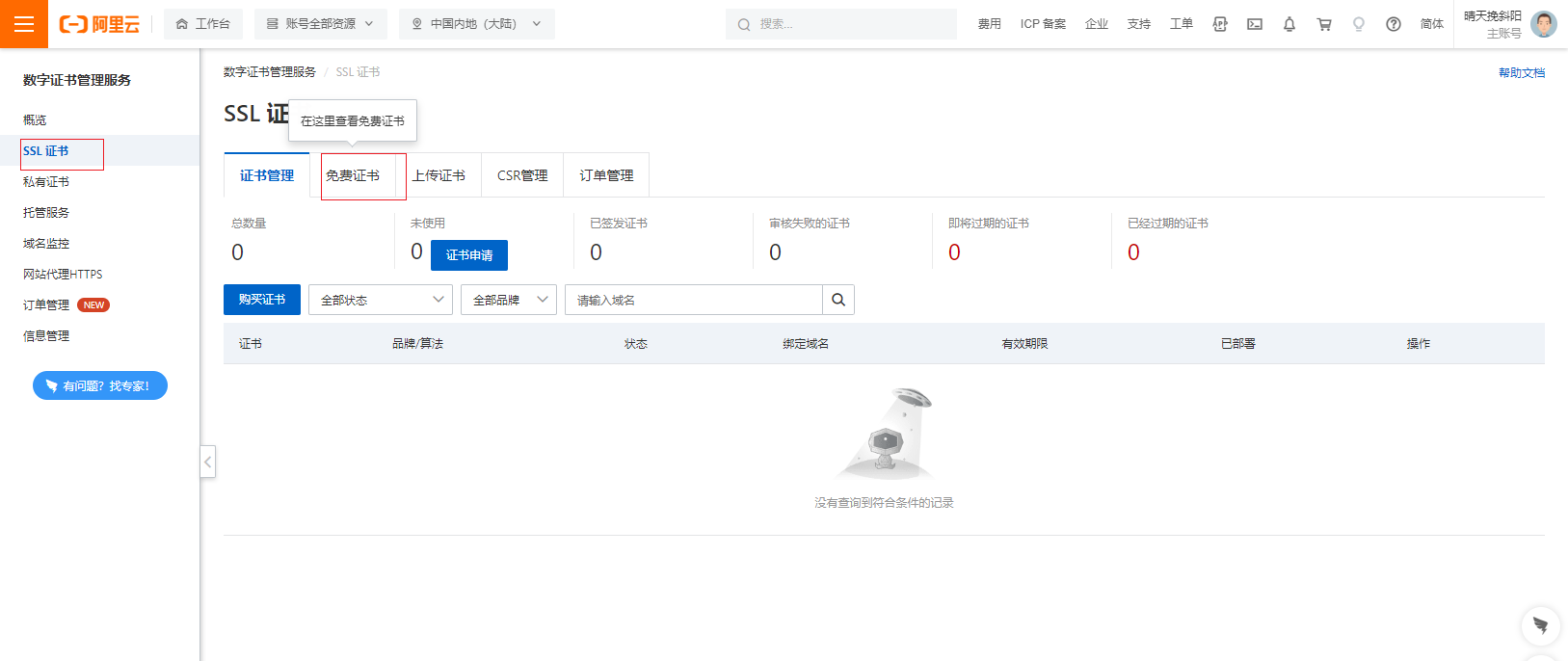
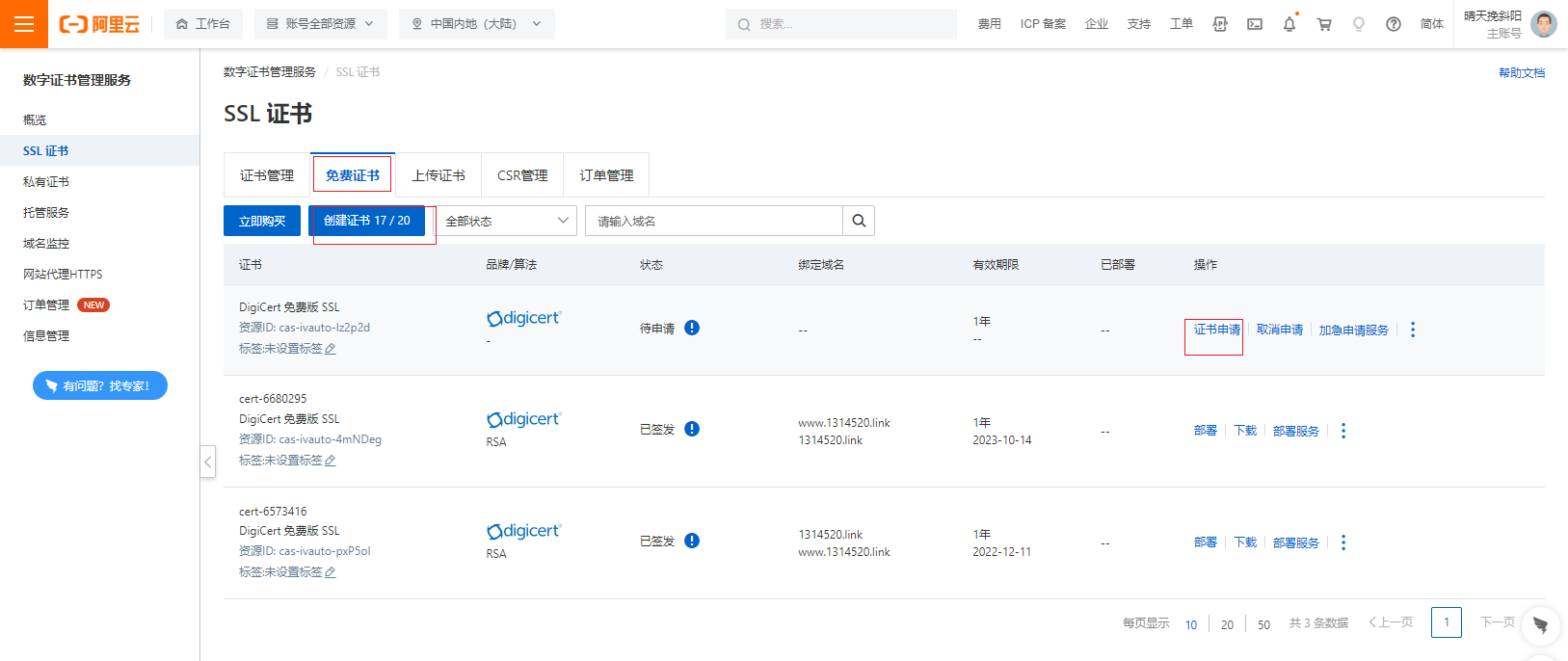

申请完成之后的状态
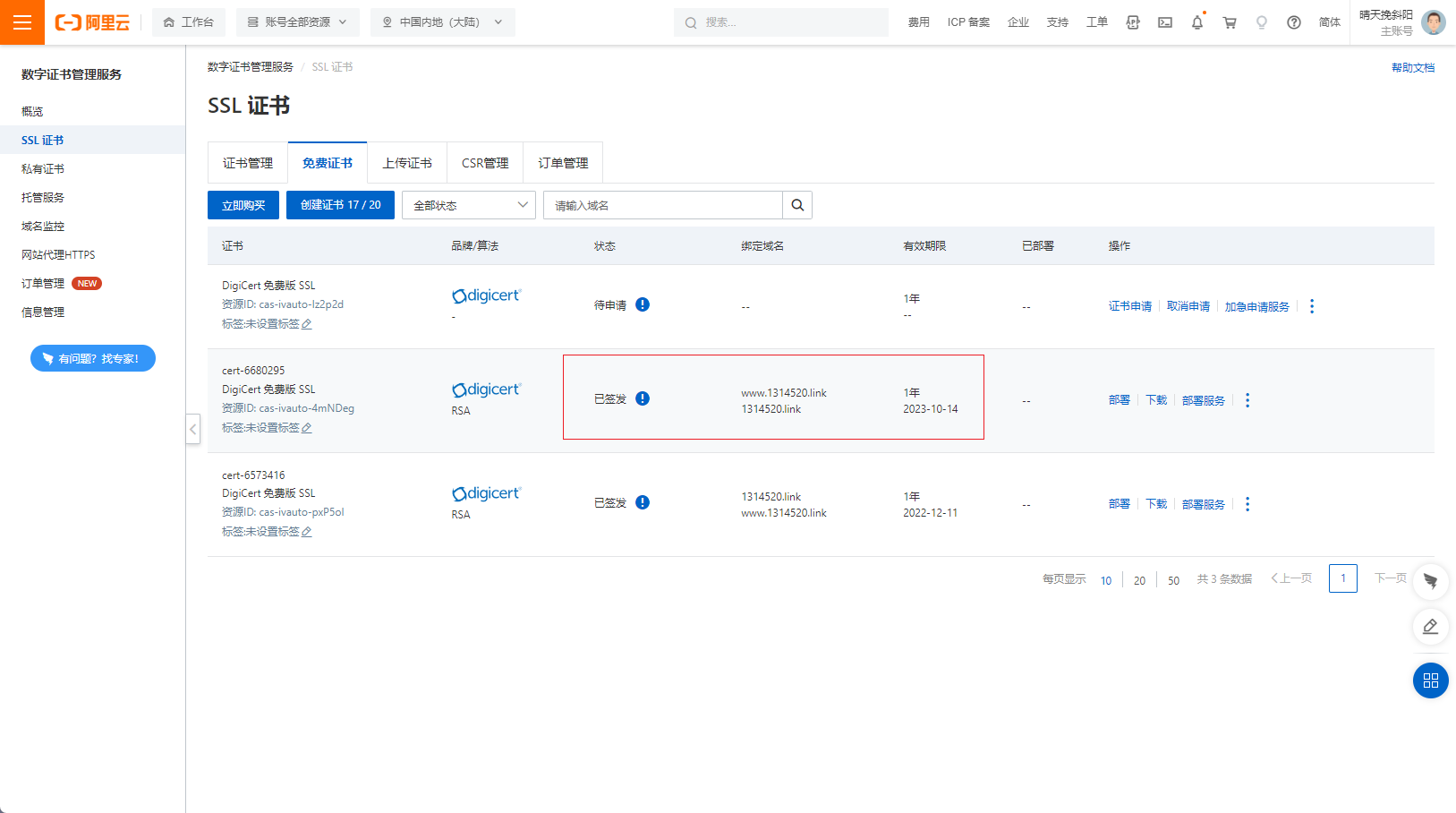
点击下载,就出现各种服务器类型证书

例如这里是nginx服务,所以下载之后放在nginx配置文件写的ssl证书的位置
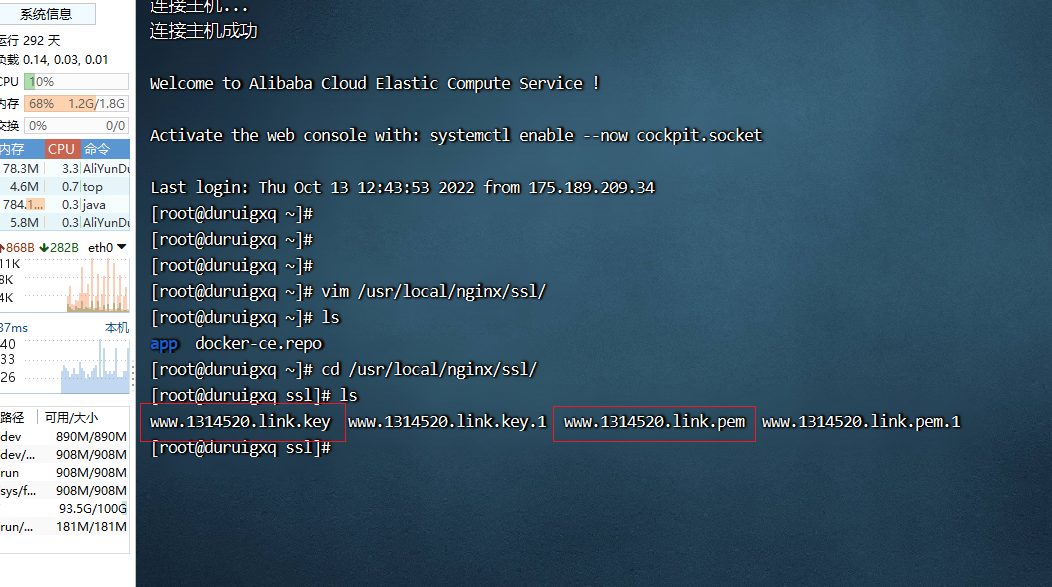
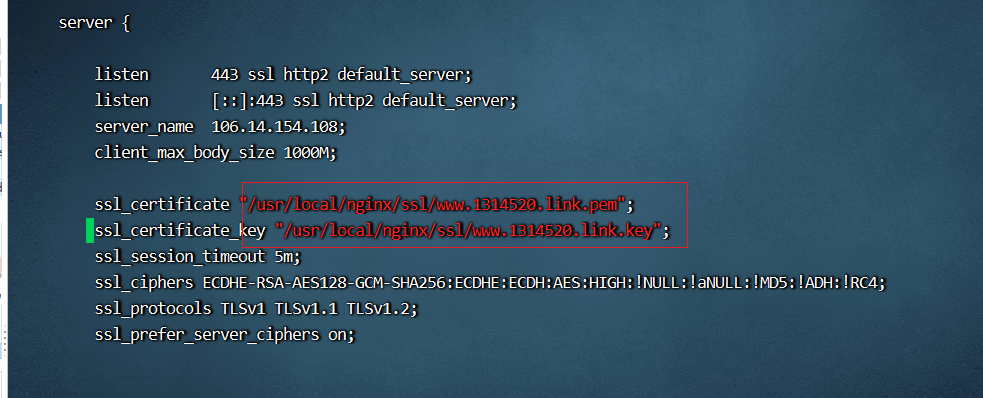
访问测试dr (1314520.link)

6.13 开启状态界面
开启status:
location /status {
stub_status {on | off};
allow 172.16.0.0/16;
deny all;
}
访问状态页面的方式:http://server_ip/status
状态页面信息详解:
| 状态码 | 表示的意义 |
|---|---|
| Active connections 2 | 当前所有处于打开状态的连接数 |
| accepts | 总共处理了多少个连接 |
| handled | 成功创建多少握手 |
| requests | 总共处理了多少个请求 |
| Reading | nginx读取到客户端的Header信息数,表示正处于接收请求状态的连接数 |
| Writing | nginx返回给客户端的Header信息数,表示请求已经接收完成, 且正处于处理请求或发送响应的过程中的连接数 |
| Waiting | 开启keep-alive的情况下,这个值等于active - (reading + writing), 意思就是Nginx已处理完正在等候下一次请求指令的驻留连接 |
开启状态页面
在安装nginx的时候需要 --with-http_stub_status_module这个模块才能开启状态页面
server {
listen 80;
server_name localhost;
#charset koi8-r;
#access_log logs/host.access.log main;
location / {
root html;
index index.html index.htm;
}
location = /status { //开启状态页面
stub_status;
}
验证
Active connections: 3
server accepts handled requests
3 3 1 //前两个跟打开浏览器访问有关,后面一个和请求有关
Reading: 0 Writing: 1 Waiting: 2
Active connections:当前所有处于打开状态的活动连接数
accepts :已经接收连接数
handled : 已经处理过的连接数
requests : 已经处理过的请求数,在保持连接模式下,请求数量可能会大于连接数量
Reading: 正处于接收请求的连接数
Writing: 请求已经接收完成,处于响应过程的连接数
Waiting : 保持连接模式,处于活动状态的连接数

使用zabbix监控nginx端的状态页,使用脚本监控的是Waiting和Reading的值
[root@nginx ~]# mkdir /scripts
[root@nginx ~]# cd /scripts/
[root@nginx scripts]# vim check_status.sh
[root@nginx scripts]# cat check_status.sh
#!/bin/bash
IP=$(ip a|grep 'inet ' |grep -v '127.0.0.1'|awk -F'[ /]+' '{print $3}') # 获取本机IP
# 取到对应的三个值
case $1 in
"Reading")
curl -s http://$IP/status |awk 'NF==6 {print $2}';;
"Writing")
curl -s http://$IP/status |awk 'NF==6 {print $4}';;
"Waiting")
curl -s http://$IP/status |awk 'NF==6 {print $6}';;
esac
安装 zabbix_agtend端
修改nginx端的 zabbix_agtend.conf 配置文件
[root@nginx ~]# useradd -r -M -s /sbin/nologin zabbix
[root@nginx ~]# dnf -y install gcc gcc-c++ vim make pcre-devel openssl openssl-devel
[root@nginx ~]# cd /usr/src/
[root@nginx src]# wget https://cdn.zabbix.com/zabbix/sources/stable/6.2/zabbix-6.2.2.tar.gz
[root@nginx src]# cd zabbix-6.2.2/
[root@nginx zabbix-6.2.2]# ./configure --enable-agent
[root@nginx zabbix-6.2.2]# make install
[root@nginx zabbix-6.2.2]# vim /usr/local/etc/zabbix_agentd.conf
.....
109 # Mandatory: yes, if StartAgents is not explicitly set to 0
110 # Default:
111 # Server=
113 Server=192.168.91.134 服务端IP (被动模式)
.....
163 # Mandatory: no
164 # Default:
165 # ServerActive=
167 ServerActive=192.168.91.134 服务端IP(主动模式)
......
178 Hostname=aa (网页里面看到的名称不是主机名,可以随便写但是网页上的名字要和这个一样)
......
UnsafeUserParameters=1 # 取消注释,把默认的0改成1
### Option: UserParameter
# User-defined parameter to monitor. There can be several user-defined parameters.
# Format: UserParameter=<key>,<shell command>
# See 'zabbix_agentd' directory for examples.
#
# Mandatory: no
# Default:
UserParameter=check_nginx_status[*],/bin/bash /scripts/check_status.sh $1
//(此key必须与web界面创建监控项时输入的key一致)
[root@nginx zabbix-6.2.2]# zabbix_agentd
[root@nginx zabbix-6.2.2]# ss -anlt
State Recv-Q Send-Q Local Address:Port Peer Address:Port Process
LISTEN 0 128 0.0.0.0:22 0.0.0.0:*
LISTEN 0 128 0.0.0.0:443 0.0.0.0:*
LISTEN 0 128 0.0.0.0:10050 0.0.0.0:*
LISTEN 0 128 0.0.0.0:111 0.0.0.0:*
LISTEN 0 128 0.0.0.0:80 0.0.0.0:*
LISTEN 0 128 [::]:22 [::]:*
LISTEN 0 128 [::]:111 [::]:*
创建主机组
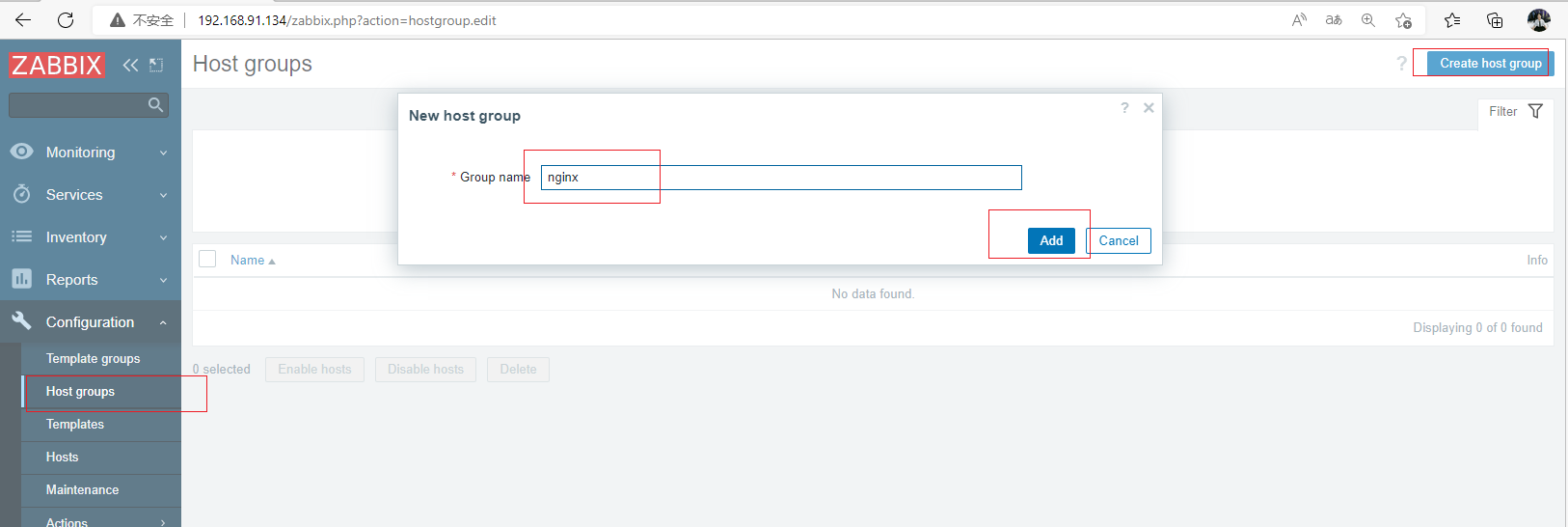
创建主机并把主机加入到主机组
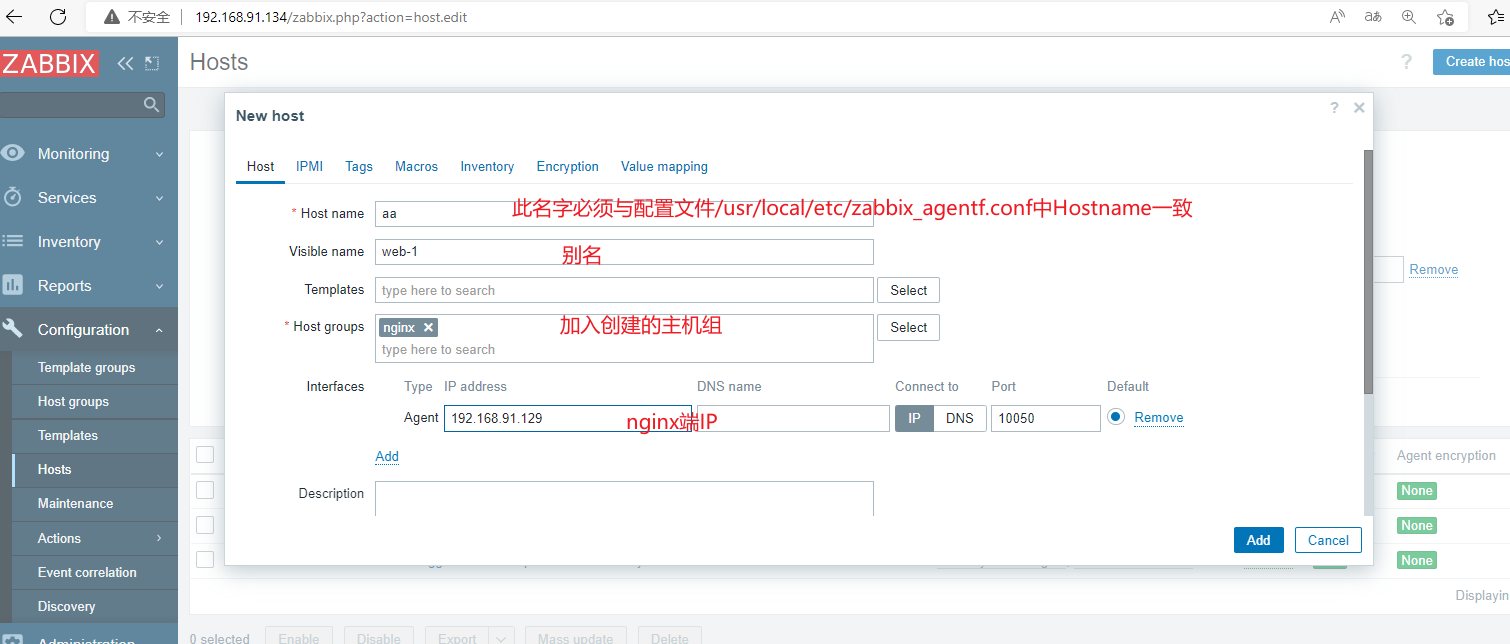
创建自定义监控 Reading 值
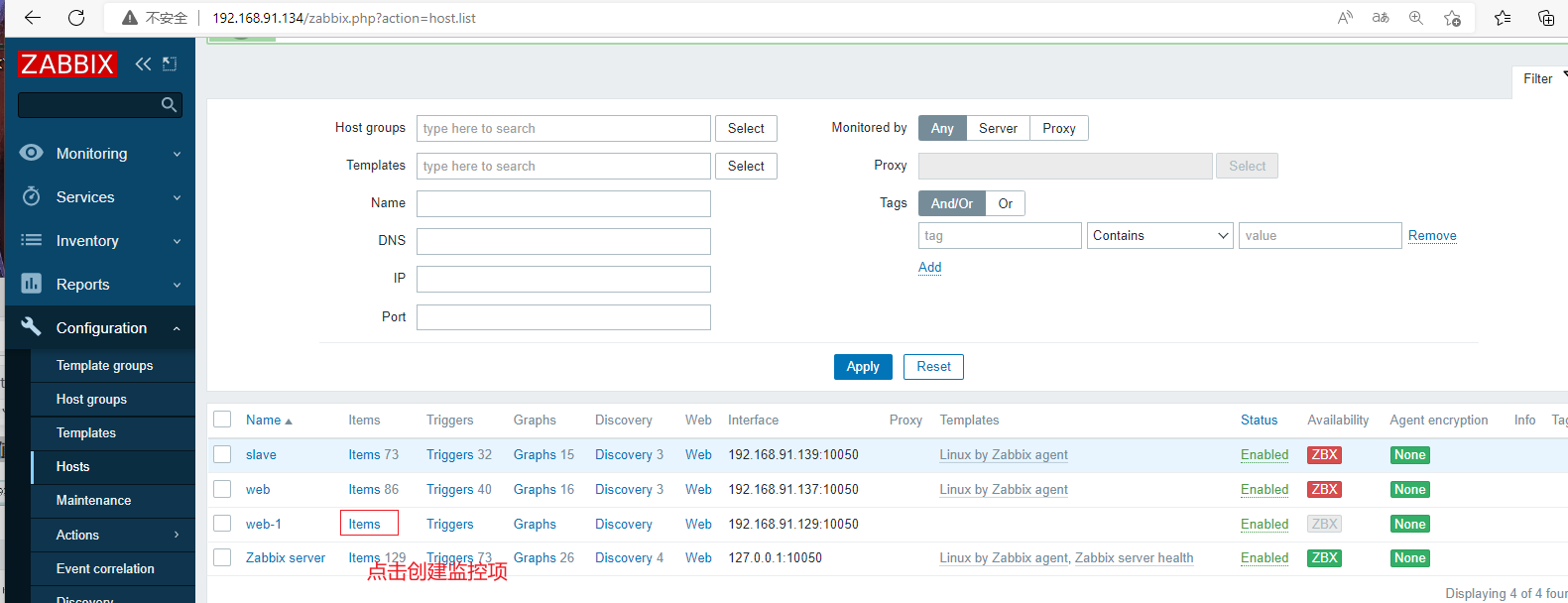
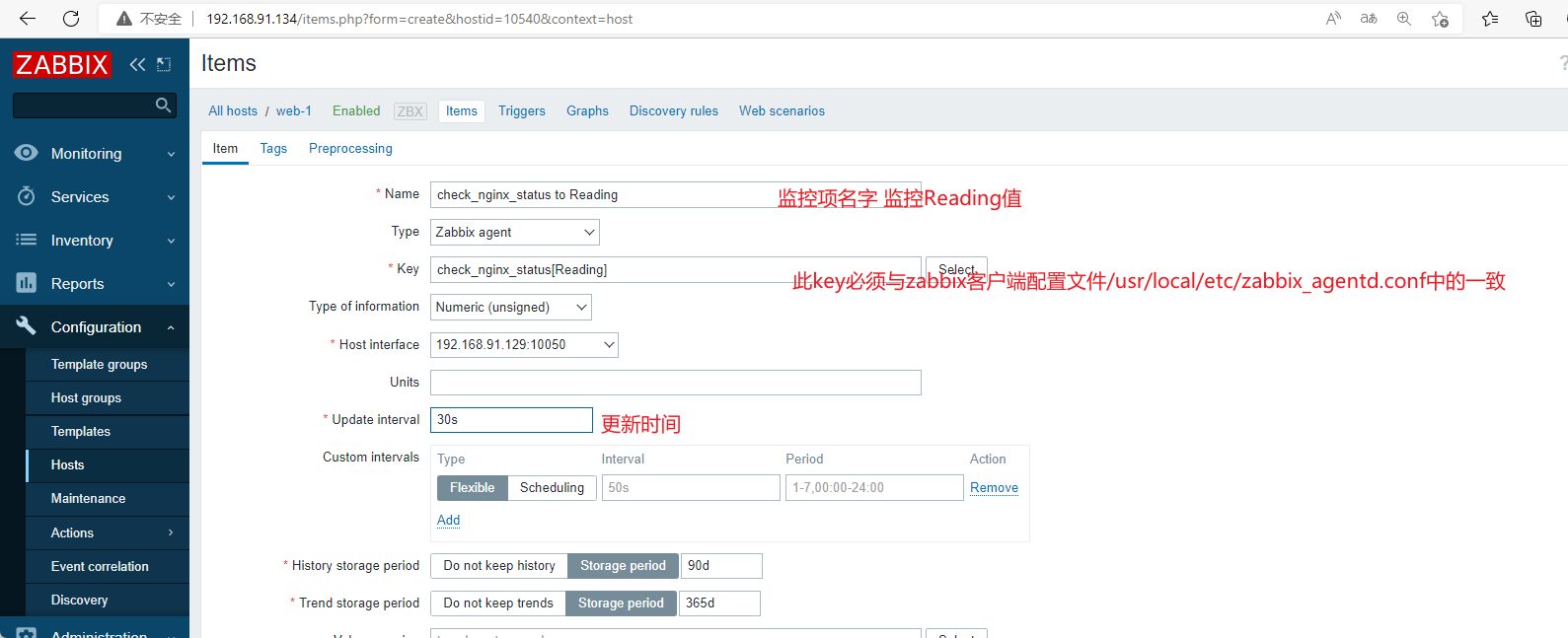
创建触发器Reading 值
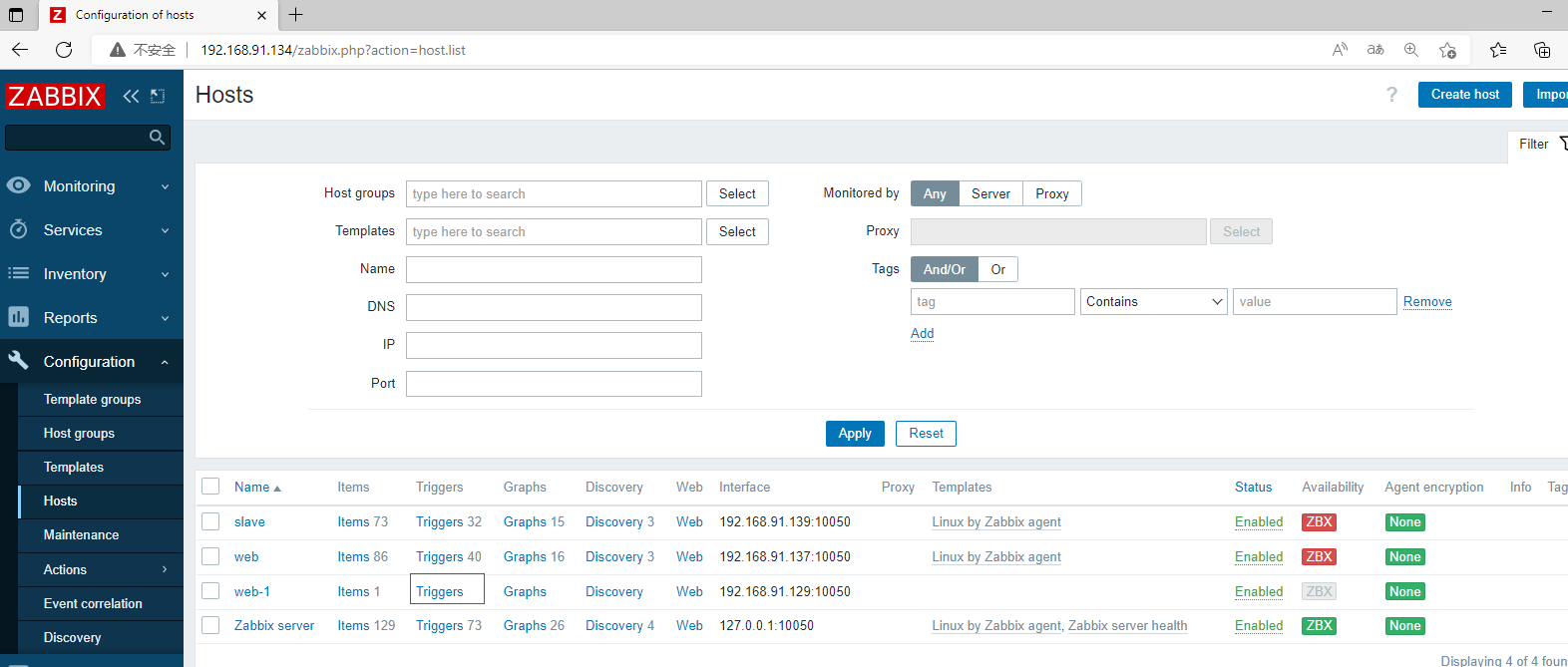
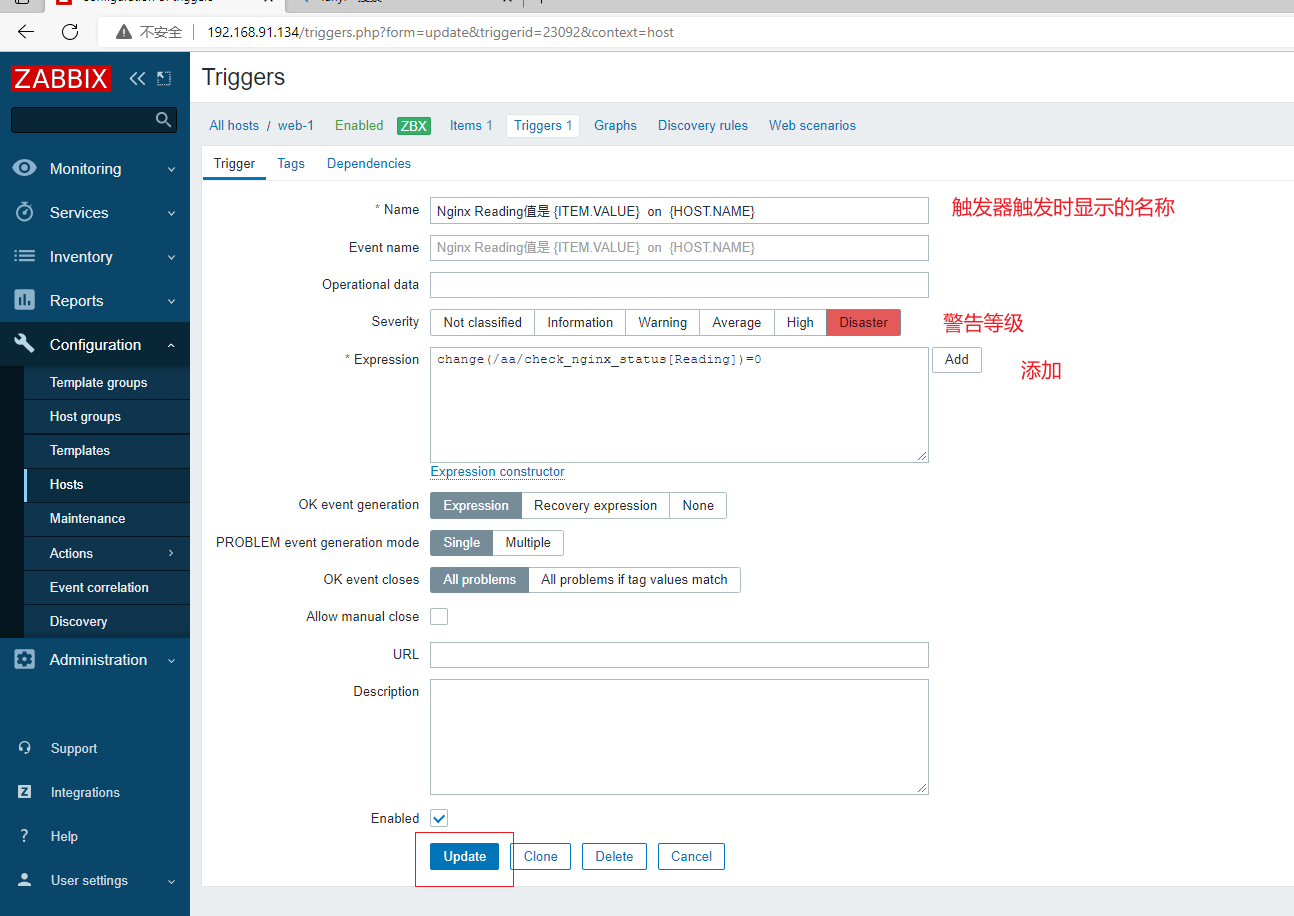
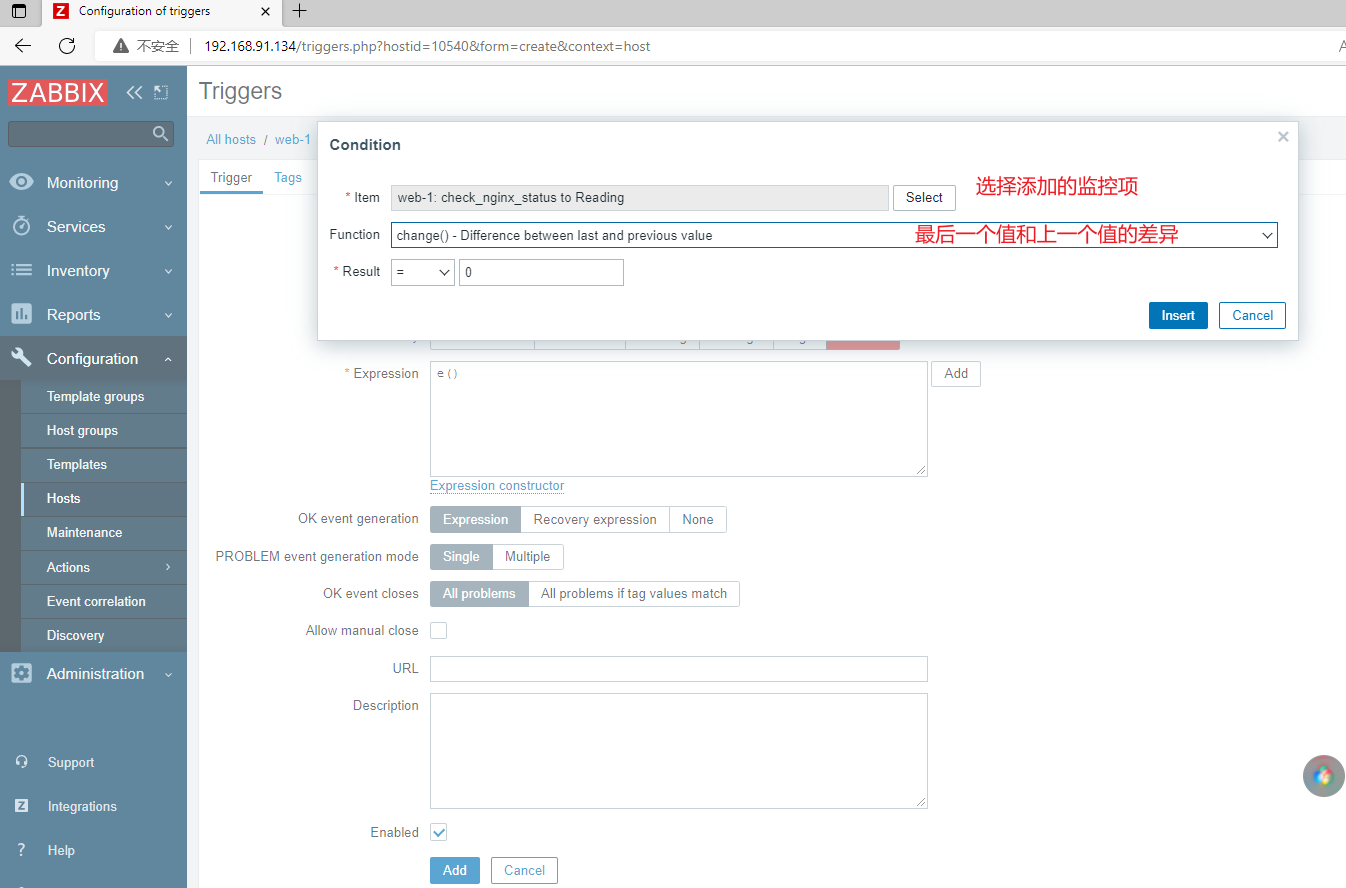
创建自定义监控 Writing 值
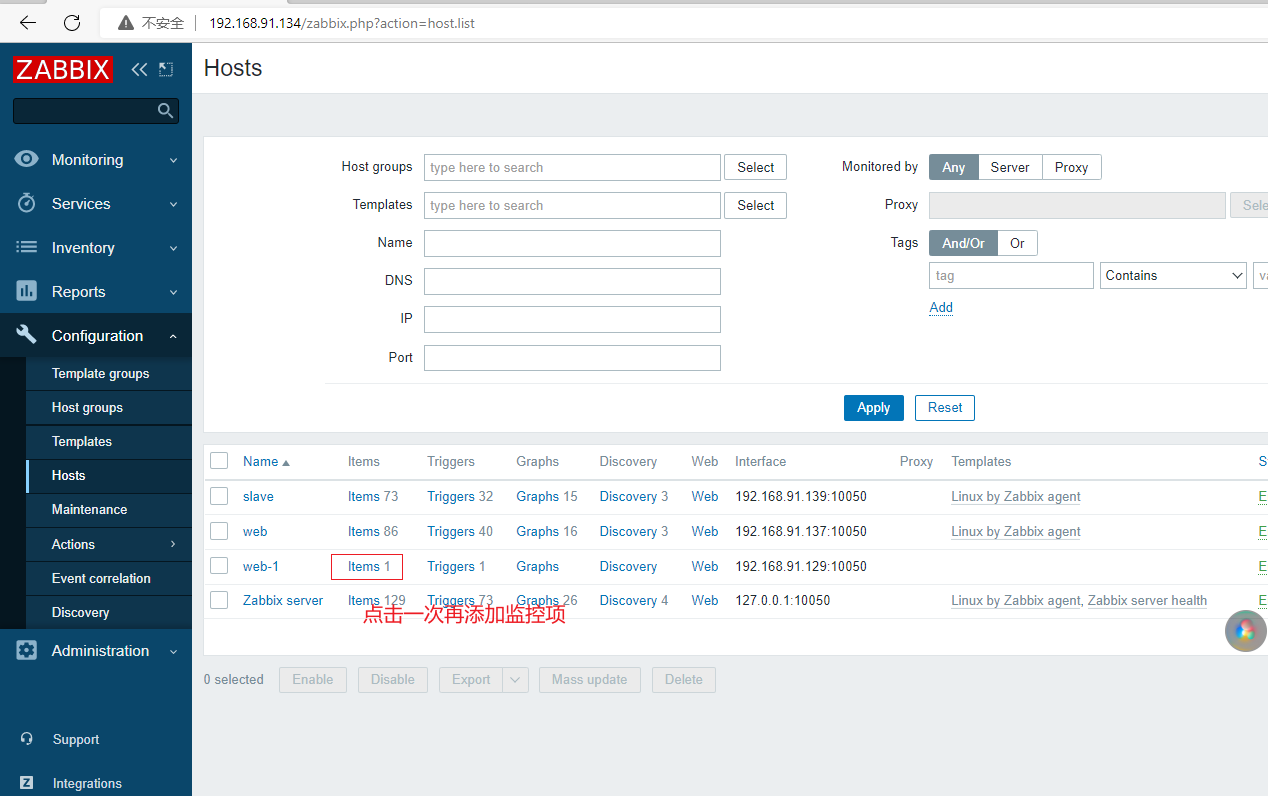
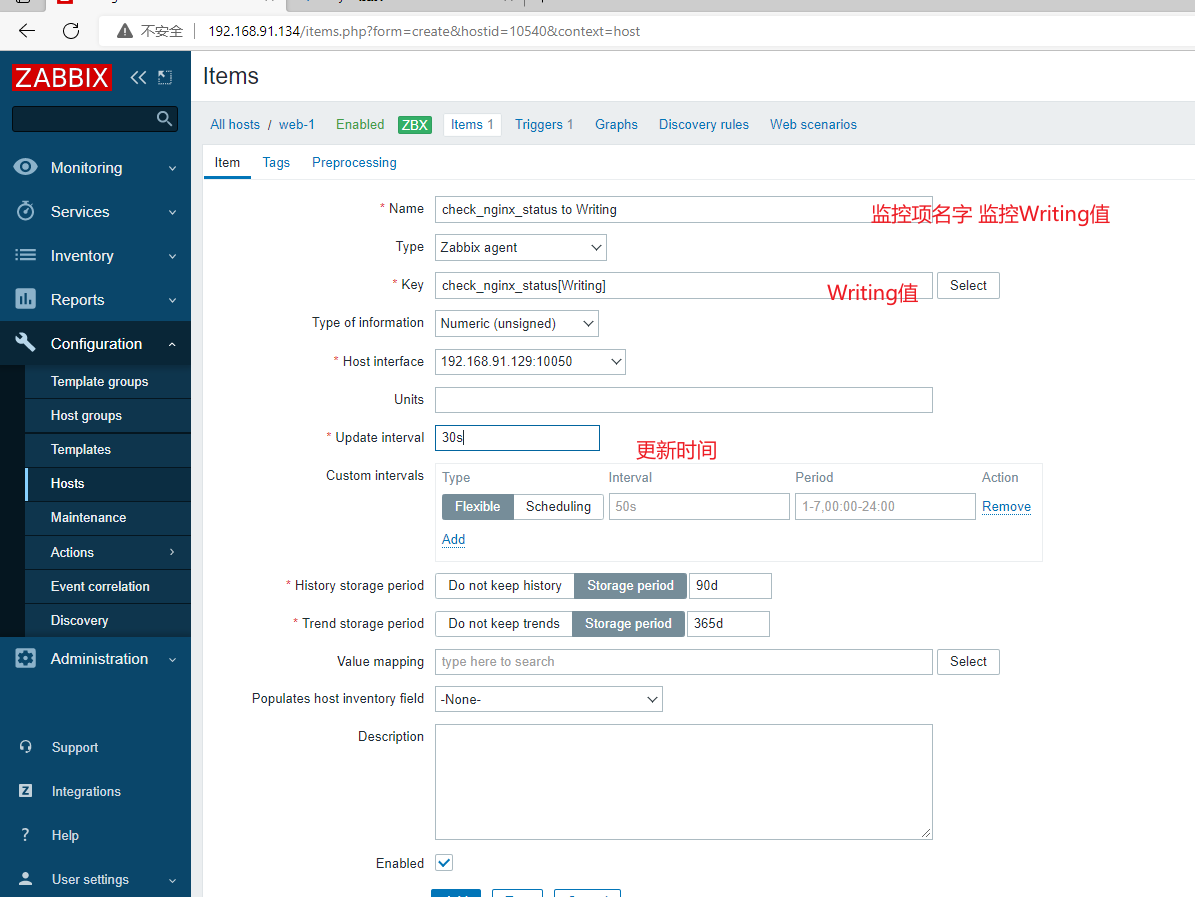
创建触发器 Writing 值
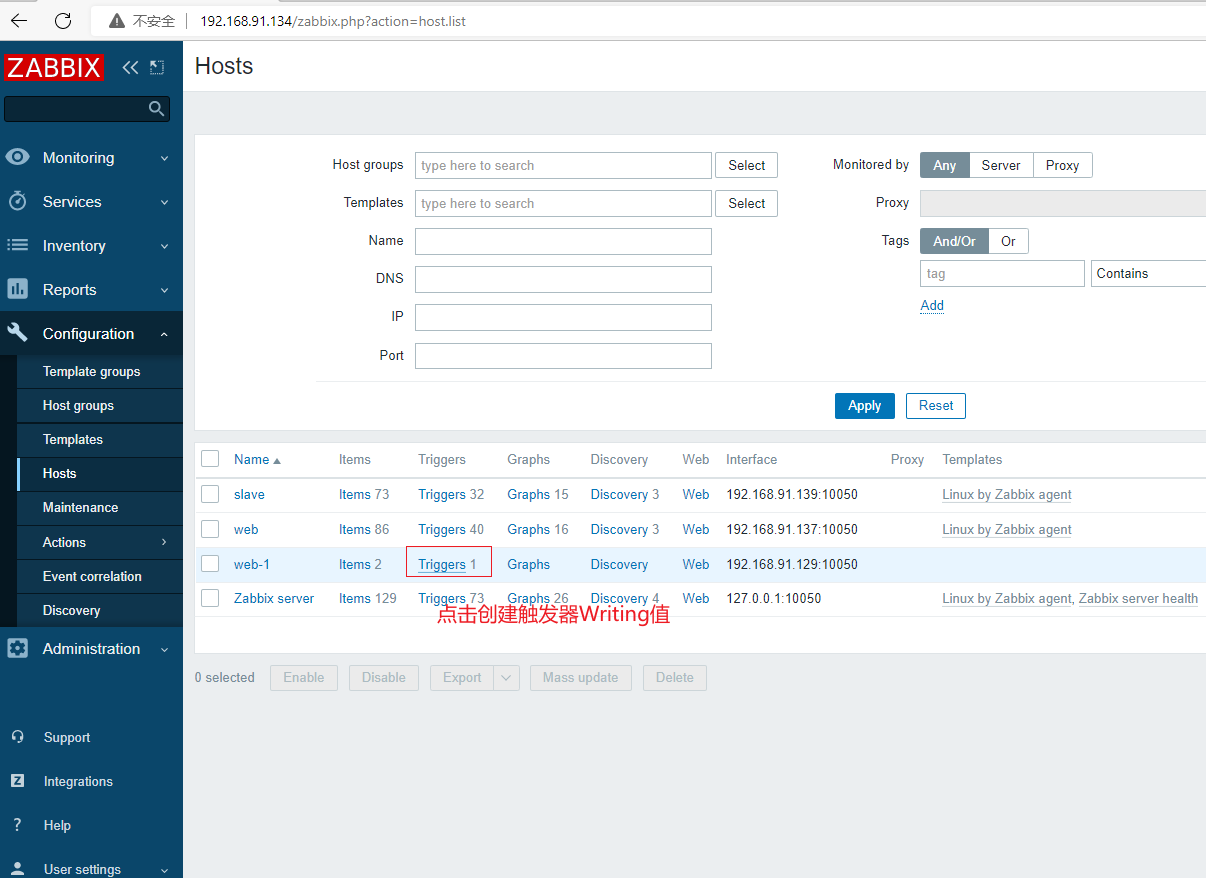
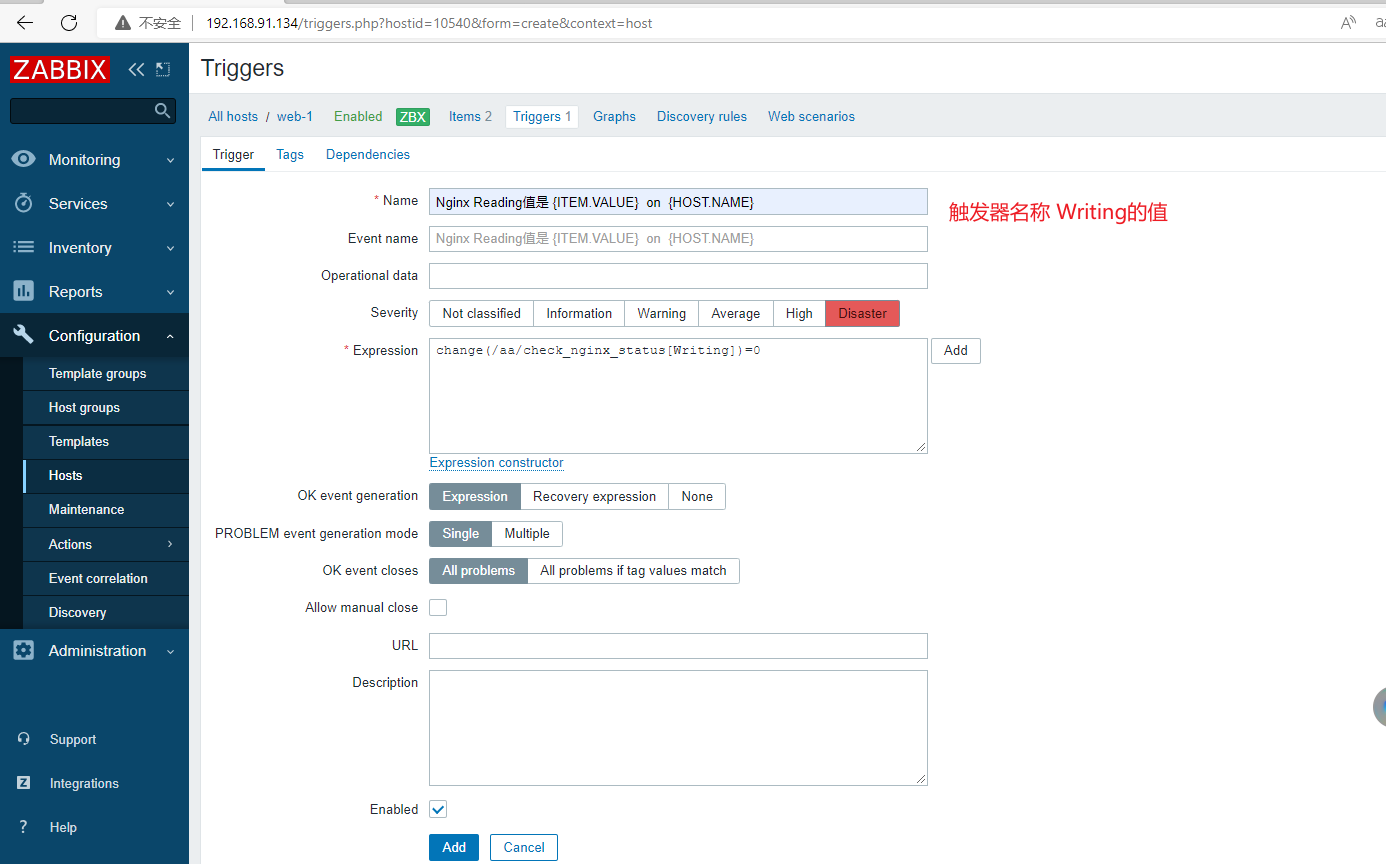
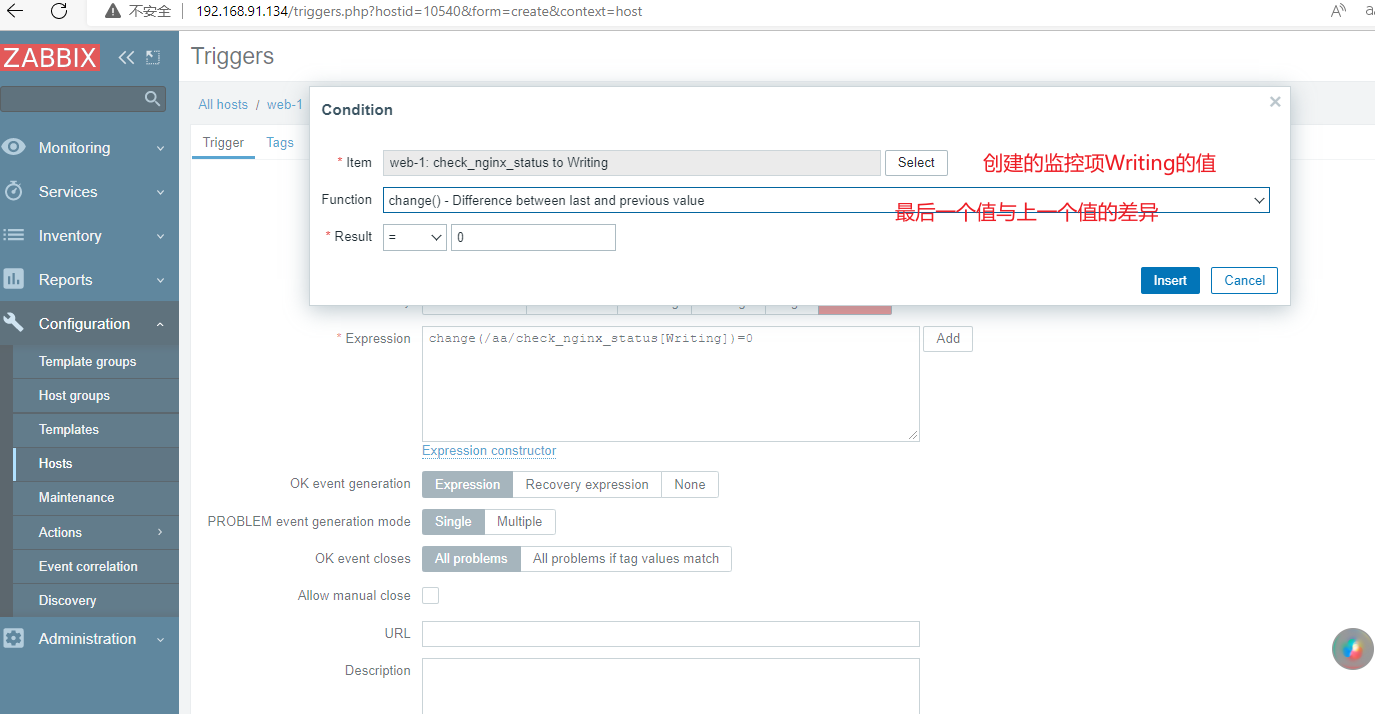
创建自定义监控 Waiting 值
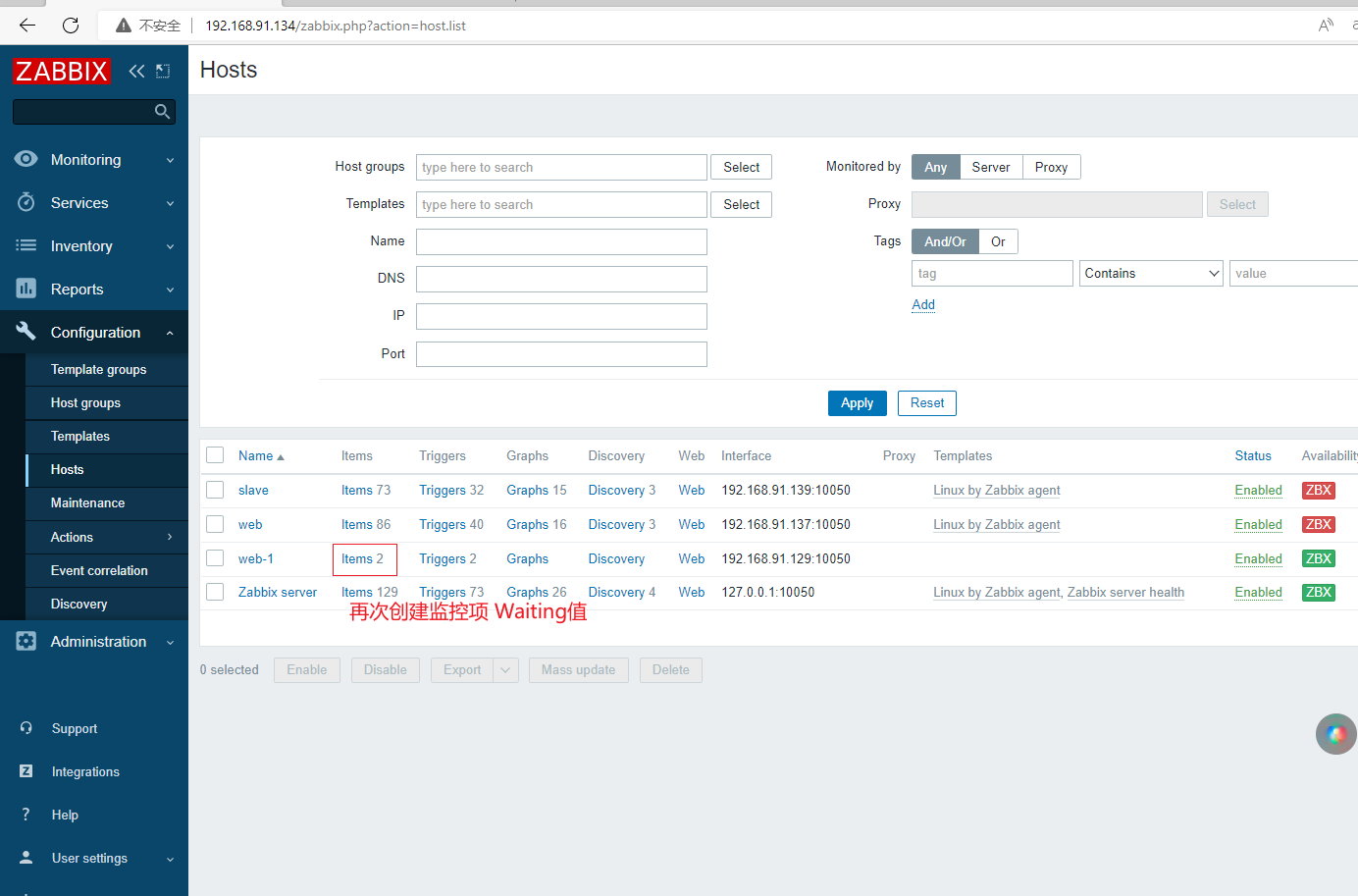
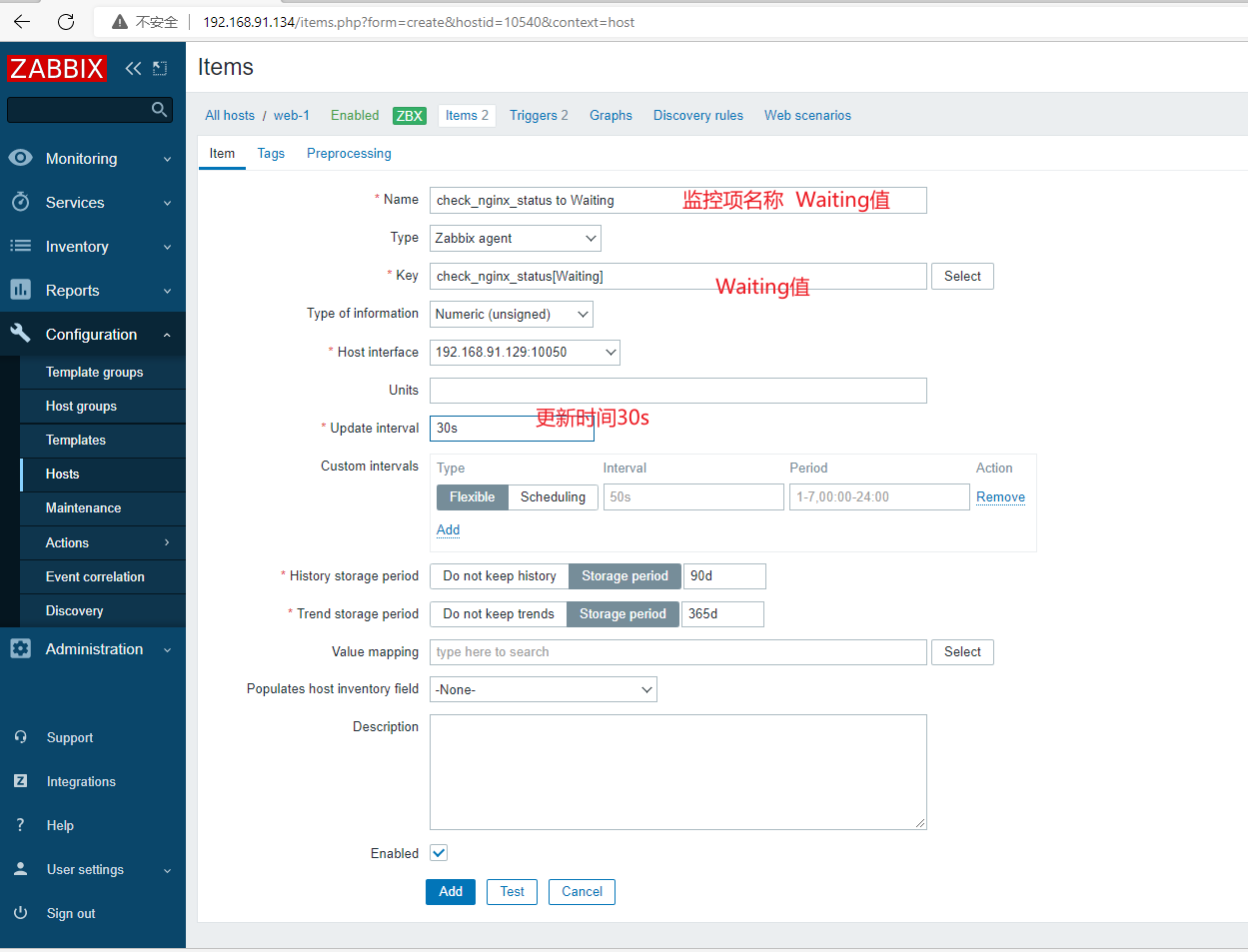
创建触发器 Waiting 值
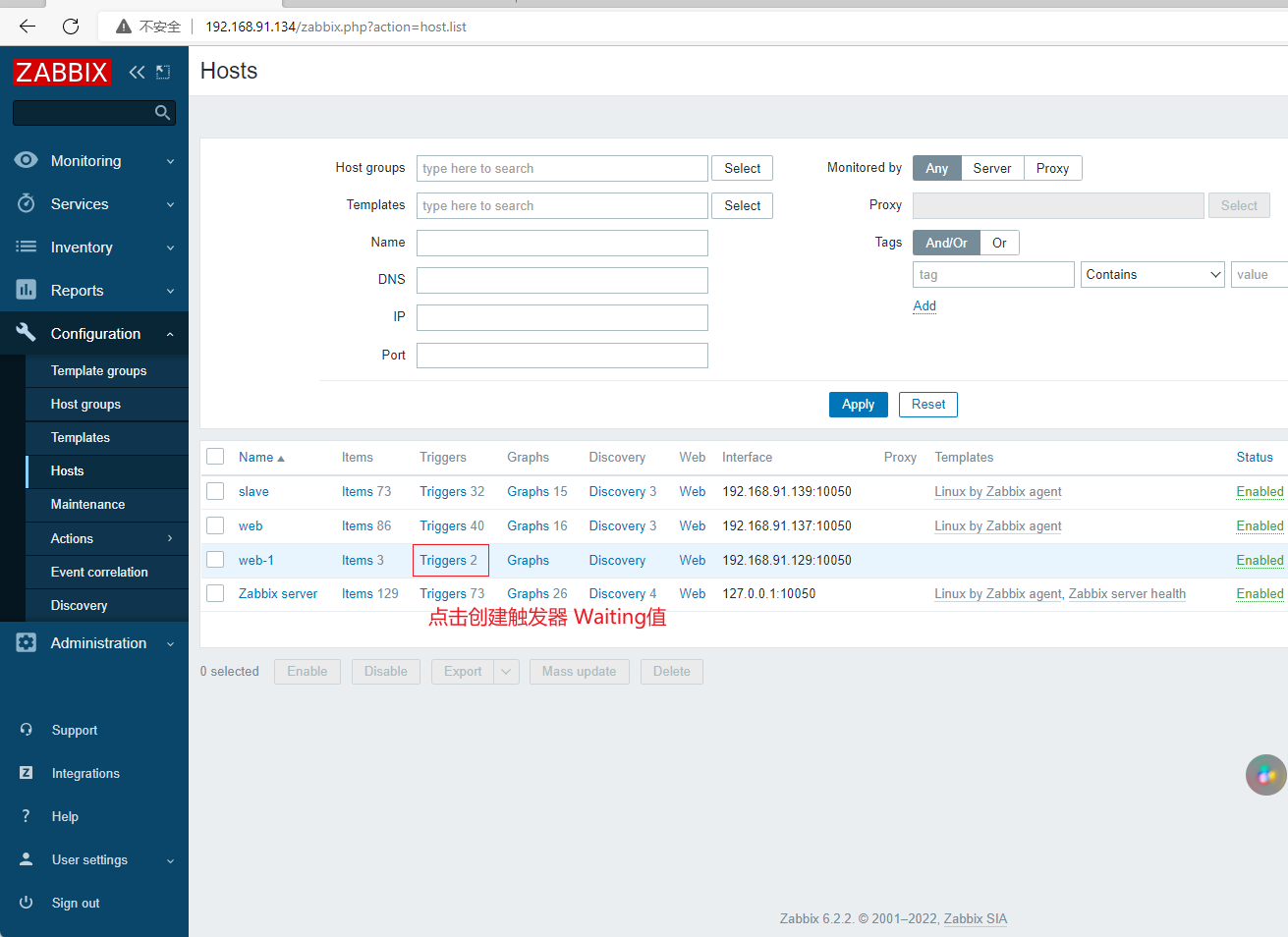
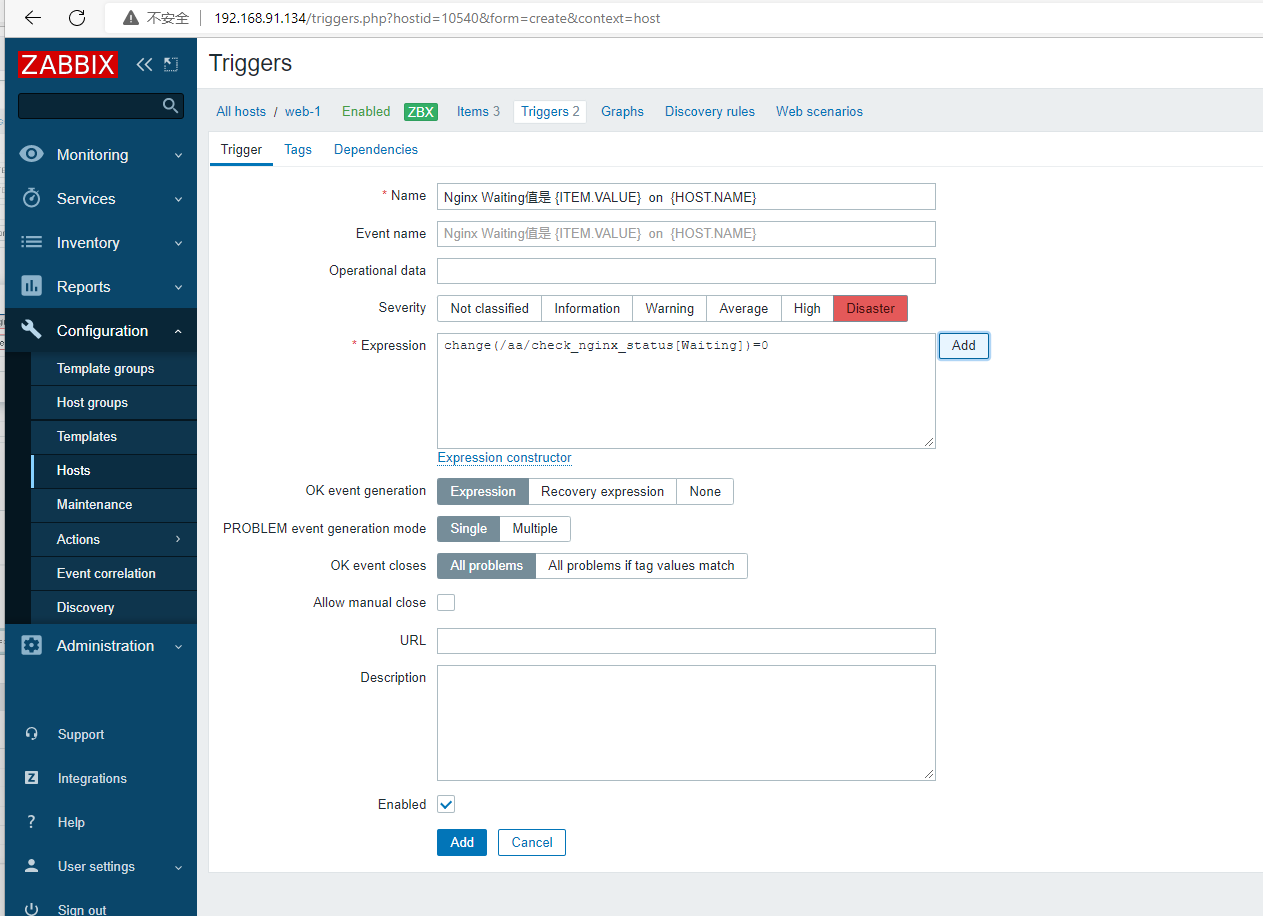
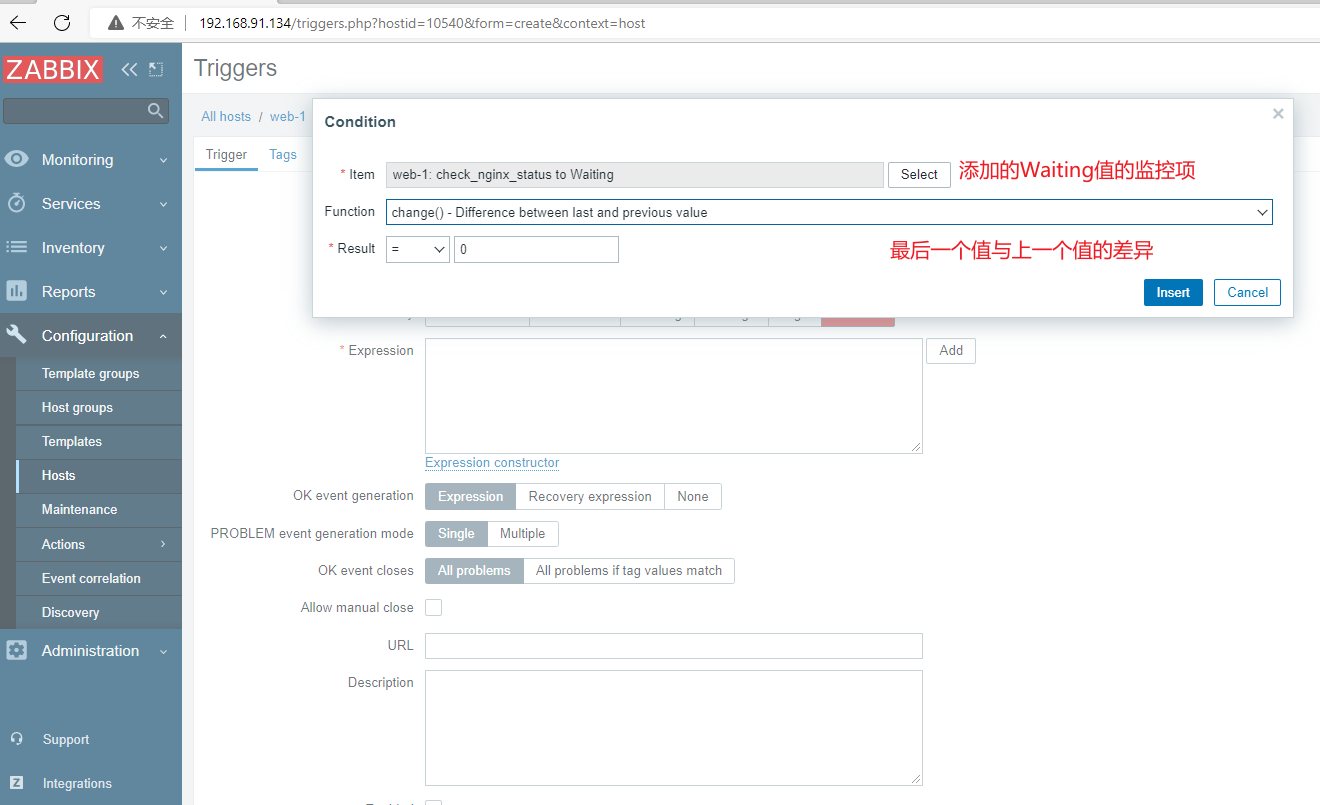
查看仪表盘

6.14 rewrite
rewrite跳转场景
1、URL看起来更规范、合理
2、企业会将动态URL地址伪装成静态地址提供服务
3、网址换新域名后,让旧的访问跳转到新的域名上
4、服务端某些业务调整
Rewrite的定义
1、rewrite功能就是使用nginx提供的全局变量或自己设置的变量,结合正则表达式和标志位实现url重写以及重定向。
2、rewrite只能放在 server { }, location { }, if { }中,并且只能对域名后边的除去传递的参数外的字符串起作用。 例如 http://xxxx.com/a/we/index.php?id=1&u=str 只对/a/we/index.php重写。
rewrite跳转实现过程
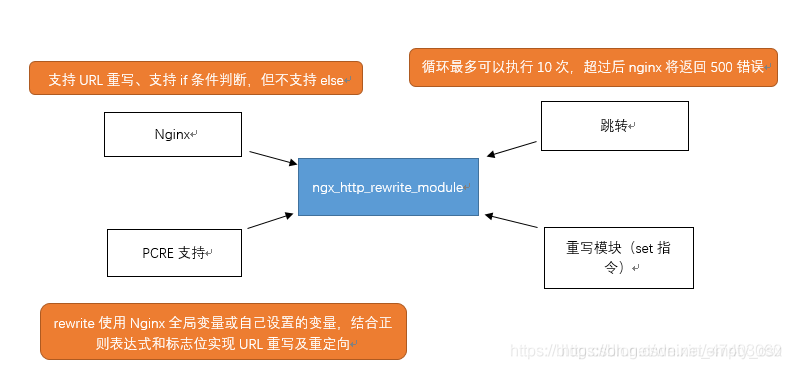
rewrite 命令语法
语法:rewrite <正则表达式> <跳转后的内容> [rewrite支持的flag标记]
如:
rewrite ^/images/(.*\.jpg)$ /imgs/$1 break;
此处的$1用于引用(.*.jpg)匹配到的内容,又如:
rewrite ^/bbs/(.*)$ http://www.idfsoft.com/index.html redirect;
此处访问ip后面加上/abc/1.png 就访问到
[root@nginx ~]# vim /usr/local/nginx/conf/nginx.conf
location /abc {
rewrite ^/abc/(.*)$ /aa/1.png break;
}
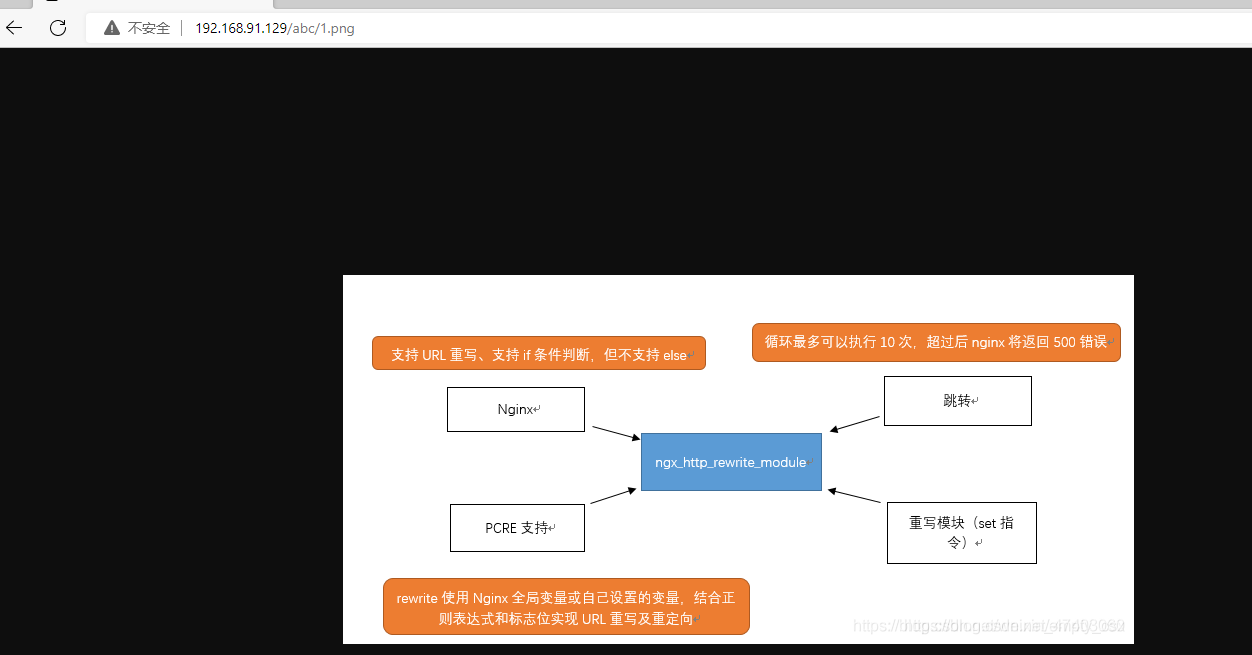
此处访问ip后面加上/abc 就访问到的是百度
[root@nginx ~]# vim /usr/local/nginx/conf/nginx.conf
//此处访问 192.168.91.129/abc 就会访问到百度
location /abc {
rewrite ^/abc/(.*)$ /aa/$1 last;
}
//到此处变成 192.168.91.129/aa/xxxx
location /aa {
rewrite ^/aa/(.*)$ /ww/$1 last;
}
//此处变成 192.168.91.129/ww/xxxx
location /ww {
rewrite ^/ww/(.*)$ http://www.baidu.com break ;
}

如上例所示,replacement可以是某个路径,也可以是某个URL
常见的flag
| flag | 作用 |
|---|---|
| last | 基本上都用这个flag,表示当前的匹配结束,继续下一个匹配,最多匹配10个到20个 一旦此rewrite规则重写完成后,就不再被后面其它的rewrite规则进行处理 而是由UserAgent重新对重写后的URL再一次发起请求,并从头开始执行类似的过程 |
| break | 中止Rewrite,不再继续匹配 一旦此rewrite规则重写完成后,由UserAgent对新的URL重新发起请求, 且不再会被当前location内的任何rewrite规则所检查 |
| redirect | 以临时重定向的HTTP状态302返回新的URL |
| permanent | 以永久重定向的HTTP状态301返回新的URL |
rewrite模块的作用是用来执行URL重定向。这个机制有利于去掉恶意访问的url,也有利于搜索引擎优化(SEO)
rewrite与location比较
1、相同点
都能实现跳转
2、不同点
rewrite是在同一域名内更改获取资源的路径
location是对一类路径做控制访问或反向代理,还可以proxy_pass到其他机器
3、rewrite会写在location里,执行顺序
执行server块里面的rewrite指令
执行location匹配
执行选定的location中的rewrite指令
nginx使用的语法源于Perl兼容正则表达式(PCRE)库,基本语法如下:
| 标识符 | 意义 |
|---|---|
| ^ | 必须以^后的实体开头 |
| $ | 必须以$前的实体结尾 |
| . | 匹配任意字符 |
| [] | 匹配指定字符集内的任意字符 |
| [^] | 匹配任何不包括在指定字符集内的任意字符串 |
| | | 匹配 | 之前或之后的实体 |
| () | 分组,组成一组用于匹配的实体,通常会有 | 来协助 |
捕获子表达式,可以捕获放在()之间的任何文本,比如:
^(hello|sir)$ //字符串为“hi sir”捕获的结果:$1=hi$2=sir
//这些被捕获的数据,在后面就可以当变量一样使用了
6.15 if
语法:if (condition) {...}
应用场景:
- server段
- location段
常见的condition
- 变量名(变量值为空串,或者以“0”开始,则为false,其它的均为true)
- 以变量为操作数构成的比较表达式(可使用=,!=类似的比较操作符进行测试)
- 正则表达式的模式匹配操作
- ~:区分大小写的模式匹配检查
- ~*:不区分大小写的模式匹配检查
- !和!*:对上面两种测试取反
- 测试指定路径为文件的可能性(-f,!-f)
- 测试指定路径为目录的可能性(-d,!-d)
- 测试文件的存在性(-e,!-e)
- 检查文件是否有执行权限(-x,!-x)
6.15.1 基于浏览器实现分离案例
if ($http_user_agent ~ Firefox) {
rewrite ^(.*)$ /firefox/$1 break;
}
if ($http_user_agent ~ MSIE) {
rewrite ^(.*)$ /msie/$1 break;
}
if ($http_user_agent ~ Chrome) {
rewrite ^(.*)$ /chrome/$1 break;
}
6.15.2 防盗链案例
location ~* \.(jpg|gif|jpeg|png)$ {
valid_referers none blocked www.idfsoft.com;
if ($invalid_referer) {
rewrite ^/ http://www.idfsoft.com/403.html;
}
}
valid_referers(有效连接)如果访问是通过网站主页点进来查看 .(jpg|gif|jpeg|png),我们就认为时有效连接就允许访问
invalid_referer(无效连接)直接通过网站输入整个的URL,不是通过网站的主页点击进去的我们就认为时无效连接,(rewrite)重新规则使无效连接访问到403.html
6.16 反向代理与负载均衡
nginx通常被用作后端服务器的反向代理,这样就可以很方便的实现动静分离以及负载均衡,从而大大提高服务器的处理能力。
nginx实现动静分离,其实就是在反向代理的时候,如果是静态资源,就直接从nginx发布的路径去读取,而不需要从后台服务器获取了。
但是要注意,这种情况下需要保证后端跟前端的程序保持一致,可以使用Rsync做服务端自动同步或者使用NFS、MFS分布式共享存储。
Http Proxy`模块,功能很多,最常用的是`proxy_pass`和`proxy_cache
如果要使用proxy_cache,需要集成第三方的ngx_cache_purge模块,用来清除指定的URL缓存。这个集成需要在安装nginx的时候去做,如:
./configure --add-module=../ngx_cache_purge-1.0 ......
nginx通过upstream模块来实现简单的负载均衡,upstream需要定义在http段内
在upstream段内,定义一个服务器列表,默认的方式是轮询,如果要确定同一个访问者发出的请求总是由同一个后端服务器来处理,可以设置ip_hash,如:
upstream idfsoft.com {
ip_hash;
server 127.0.0.1:9080 weight=5;
server 127.0.0.1:8080 weight=5;
server 127.0.0.1:1111;
}
注意:这个方法本质还是轮询,而且由于客户端的ip可能是不断变化的,比如动态ip,代理,翻墙等,因此ip_hash并不能完全保证同一个客户端总是由同一个服务器来处理。
定义好upstream后,需要在server段内添加如下内容:
server {
location / {
proxy_pass http://idfsoft.com;
}
}
nginx负载均衡配置、nginx负载均衡调度器高可用配置
环境说明
| 系统信息 | 主机名 | IP |
|---|---|---|
| CentOS8 | 129 (nginx,keepalived) | 192.168.91.129 |
| CentOS8 | 134 (nginx,keepalived) | 192.168.91.134 |
| CentOS8 | 139 (httpd) | 192.168.91.139 |
| CentOS8 | 145 (nginx) | 192.168.91.145 |
//在139上源码安装httpd
创建apache服务的用户和组
[root@139 ~]# groupadd -r apache
[root@139 ~]# useradd -r -M -s /sbin/nologin -g apache apache
安装依赖包
[root@139 ~]# yum -y install openssl-devel pcre-devel expat-devel libtool gcc gcc-c++
下载安装apr apr-util
[root@139 ~]# wget https://mirrors.tuna.tsinghua.edu.cn/apache/apr/apr-1.7.0.tar.bz2
[root@139 ~]# wget https://mirrors.tuna.tsinghua.edu.cn/apache/apr/apr-util-1.6.1.tar.bz2
解压下载的源码包
[root@139 ~]#tar -jxf apr-1.7.0.tar.bz2 -C /usr/local/src/
[root@139 ~]#tar -jxf apr-util-1.6.1.tar.bz2 -C /usr/local/src/
[root@139 src]# cd apr-1.7.0
[root@139 apr-1.6.5]# vim configure
cfgfile="${ofile}T"
trap "$RM \"$cfgfile\"; exit 1" 1 2 15
# $RM "$cfgfile" 将此行加上注释,或者删除此行
安装apr
[root@139 ~]# cd /usr/local/src/apr-1.7.0/
[root@139 apr-1.7.0]# ./configure --prefix=/usr/local/apr
[root@139 apr-1.7.0]# make && make install
安装apr-util
[root@139 ~]# cd /usr/local/src/
[root@139 apr-util-1.6.1]# ./configure --prefix=/usr/local/apr-util --with-apr=/usr/local/apr
[root@139 apr-util-1.6.1]#make && make install
安装httpd
[root@139 ~]#wgt https://downloads.apache.org/httpd/httpd-2.4.54.tar.bz2
[root@139 ~]# tar -jxf httpd-2.4.54.tar.bz2 -C /usr/local/src/
[root@139 ~]#cd /usr/local/src/httpd-2.4.54
[root@139 httpd-2.4.54]# ./configure --prefix=/usr/local/apache \
--sysconfdir=/etc/apache \
--enable-so \
--enable-ssl \
--enable-cgi \
--enable-rewrite \
--with-zlib \
--with-pcre \
--with-apr=/usr/local/apr \
--with-apr-util=/usr/local/apr-util/ \
--enable-modules=most \
--enable-mpms-shared=all \
--with-mpm=prefork
[root@139 httpd-2.4.54]#make && make install
安装后配置
[root@139 ~]# echo 'export PATH=/usr/local/apache/bin:$PATH' > /etc/profile.d/httpd.sh
[root@139 ~]# source /etc/profile.d/httpd.sh
[root@139 ~]# ln -s /usr/local/apache/include/ /usr/include/httpd
[root@139 ~]# echo 'MANDATORY_MANPATH /usr/local/apache/man' >> /etc/man_db.conf
取消ServerName前面的注释
[root@139 ~]# sed -i '/#ServerName/s/#//g' /etc/apache/httpd.conf
设置源码安装apache能使用systemctl 开启、关闭、重启、开机自启
[root@139 ~]# cd /usr/lib/systemd/system
[root@139 system]# cp sshd.service apache.service复制sshd.service,改名为httpd.service
[root@139 system]#vim apache.service 进入apache.service进行修改,保存退出
[root@139 system]#cat apache.service 显示修改后的文件内容
[Unit]
Description=httpd server daemon
After=network.target sshd-keygen.target
[Service]
Type=forking
ExecStart=/usr/local/apache/bin/apachectl
ExecStop=/usr/local/apache/bin/apachectl stop
ExecReload=/bin/kill -HUP $MAINPID
[root@139 ~]#systemctl start httpd.service 开启apache服务
[root@139 ~]# ss -anlt
State Recv-Q Send-Q Local Address:Port Peer Address:Port Process
LISTEN 0 128 0.0.0.0:22 0.0.0.0:*
LISTEN 0 128 *:80 *:*
LISTEN 0 128 [::]:22 [::]:*
//在145上源码部署nginx
//创建系统用户nginx
[root@145 ~]# useradd -r -M -s /sbin/nologin nginx
//安装依赖环境
[root@145 ~]# yum -y install pcre-devel openssl openssl-devel gd-devel gcc gcc-c++ wget make
[root@145 ~]# yum -y groups mark install 'Development Tools'
//创建日志存放目录
[root@145 ~]# mkdir -p /var/log/nginx
[root@145 ~]# chown -R nginx.nginx /var/log/nginx
//下载nginx
//nginx 官网 https://nginx.org/en/download.html
[root@145 ~]# cd /usr/local/src/
[root@145 ~]# wget https://nginx.org/download/nginx-1.20.2.tar.gz
//编译安装
[root@145 src]# ls
nginx-1.20.2.tar.gz
[root@145 src]# tar -xf nginx-1.20.2.tar.gz
[root@145 src]# cd nginx-1.20.2/
[root@145 nginx-1.20.2]# ./configure \
--prefix=/usr/local/nginx \
--user=nginx \
--group=nginx \
--with-debug \
--with-http_ssl_module \
--with-http_realip_module \
--with-http_image_filter_module \
--with-http_gunzip_module \
--with-http_gzip_static_module \
--with-http_stub_status_module \
--http-log-path=/var/log/nginx/access.log \
--error-log-path=/var/log/nginx/error.log
[root@145 nginx-1.20.2]# make -j $(grep 'processor' /proc/cpuinfo | wc -l) && make install
//配置环境变量
[root@145 ~]# echo 'export PATH=/usr/local/nginx/sbin:$PATH' > /etc/profile.d/nginx.sh
[root@145 ~]# . /etc/profile.d/nginx.sh
设置nginx 开机自启
[root@145 ~]# cp /usr/lib/systemd/system/sshd.service /usr/lib/systemd/system/nginx.service
[root@145 ~]# vim /usr/lib/systemd/system/nginx.service
[root@145 ~]# cat /usr/lib/systemd/system/nginx.service
[Unit]
Description=nginx server daemon
After=network.target
[Service]
Type=forking
ExecStart=/usr/local/nginx/sbin/nginx
ExecStop=/usr/local/nginx/sbin/nginx -s stop
ExecReload=/bin/kill -HUP $MAINPID
[Install]
WantedBy=multi-user.target
[root@145 ~]# systemctl daemon-reload
[root@145 ~]# systemctl enable --now nginx.service
[root@145 ~]# ss -anlt
State Recv-Q Send-Q Local Address:Port Peer Address:Port Process
LISTEN 0 128 0.0.0.0:80 0.0.0.0:*
LISTEN 0 128 0.0.0.0:22 0.0.0.0:*
LISTEN 0 128 [::]:22 [::]:*
//在129上安装nginx
//源码安装nginx就行,这台只是做一个代理转发
[root@129 ~]# yum -y install nginx
[root@129 ~]# vim /etc/nginx/nginx.conf
.......
upstream 1314.com {
server 192.168.91.139 weight=5; //weight访问比重,两个都是5时访问是一样一次
server 192.168.91.145 weight=5;
}
server {
listen 80 default_server;
listen [::]:80 default_server;
server_name _;
root /usr/share/nginx/html;
# Load configuration files for the default server block.
include /etc/nginx/default.d/*.conf;
location / {
proxy_pass http://1314.com; //做转发,转发到上面的upstream
}
[root@129 ~]# systemctl enable --now nginx.service
测试
第一次访问


//在134上也安装nginx
//源码安装nginx就行,这台只是做一个代理转发
[root@134 ~]# yum -y install nginx
//应为129和134上的nginx配置是一样的都是做转发,直接把129上的nginx.conf复制去替换
[root@129 ~]# scp -r /etc/nginx/nginx.conf root@192.168.91.134:/etc/nginx/
[root@134 ~]# systemctl enable --now nginx.service
访问测试


//在129和134上分别安装keepalived做高可用
//在129上安装keepalived,把129作为主
[root@129 ~]# yum -y install keepalived
//配置主keepalived
[root@129 ~]# cd /etc/keepalived/
[root@129 keepalived]# mv keepalived.conf keepalived.conf.bak
[root@129 keepalived]# vi keepalived.conf
[root@129 keepalived]# cat keepalived.conf
! Configuration File for keepalived
global_defs {
router_id lb01
}
vrrp_instance VI_1 {
state MASTER
interface ens33
virtual_router_id 51
priority 100
advert_int 1
authentication {
auth_type PASS
auth_pass 123456
}
virtual_ipaddress {
192.168.91.250
}
}
virtual_server 192.168.91.250 80 {
delay_loop 6
lb_algo rr
lb_kind DR
persistence_timeout 50
protocol TCP
real_server 192.168.91.129 80 {
weight 1
TCP_CHECK {
connect_port 80
connect_timeout 3
nb_get_retry 3
delay_before_retry 3
}
}
real_server 192.168.91.134 80 {
weight 1
TCP_CHECK {
connect_port 80
connect_timeout 3
nb_get_retry 3
delay_before_retry 3
}
}
}
[root@129 ~]# systemctl enable --now keepalived.service
// 配置备keepalived
[root@134 ~]# yum -y install keepalived
[root@129 keepalived]# scp keepalived.conf root@192.168.91.134:/etc/keepalived/
[root@134 ~]# vim /etc/keepalived/keepalived.conf
[root@134 ~]# cat /etc/keepalived/keepalived.conf
! Configuration File for keepalived
global_defs {
router_id lb01
}
vrrp_instance VI_1 {
state BACKUP
interface ens33
virtual_router_id 51
priority 90
advert_int 1
authentication {
auth_type PASS
auth_pass 123456
}
virtual_ipaddress {
192.168.91.250
}
}
virtual_server 192.168.91.250 80 {
delay_loop 6
lb_algo rr
lb_kind DR
persistence_timeout 50
protocol TCP
real_server 192.168.91.129 80 {
weight 1
TCP_CHECK {
connect_port 80
connect_timeout 3
nb_get_retry 3
delay_before_retry 3
}
}
real_server 192.168.91.134 80 {
weight 1
TCP_CHECK {
connect_port 80
connect_timeout 3
nb_get_retry 3
delay_before_retry 3
}
}
}
[root@134 ~]# systemctl enable --now keepalived.service
//查看VIP在哪里
[root@129 ~]# ip a
1: lo: <LOOPBACK,UP,LOWER_UP> mtu 65536 qdisc noqueue state UNKNOWN group default qlen 1000
link/loopback 00:00:00:00:00:00 brd 00:00:00:00:00:00
inet 127.0.0.1/8 scope host lo
valid_lft forever preferred_lft forever
inet6 ::1/128 scope host
valid_lft forever preferred_lft forever
2: ens33: <BROADCAST,MULTICAST,UP,LOWER_UP> mtu 1500 qdisc fq_codel state UP group default qlen 1000
link/ether 00:0c:29:b8:32:24 brd ff:ff:ff:ff:ff:ff
inet 192.168.91.129/24 brd 192.168.91.255 scope global noprefixroute ens33
valid_lft forever preferred_lft forever
inet 192.168.91.250/32 scope global ens33 //在129上
valid_lft forever preferred_lft forever
inet6 fe80::20c:29ff:feb8:3224/64 scope link noprefixroute
valid_lft forever preferred_lft forever
[root@134 ~]# ip a
1: lo: <LOOPBACK,UP,LOWER_UP> mtu 65536 qdisc noqueue state UNKNOWN group default qlen 1000
link/loopback 00:00:00:00:00:00 brd 00:00:00:00:00:00
inet 127.0.0.1/8 scope host lo
valid_lft forever preferred_lft forever
inet6 ::1/128 scope host
valid_lft forever preferred_lft forever
2: ens33: <BROADCAST,MULTICAST,UP,LOWER_UP> mtu 1500 qdisc fq_codel state UP group default qlen 1000
link/ether 00:0c:29:70:9e:3b brd ff:ff:ff:ff:ff:ff
inet 192.168.91.134/24 brd 192.168.91.255 scope global noprefixroute ens33
valid_lft forever preferred_lft forever
inet6 fe80::20c:29ff:fe70:9e3b/64 scope link noprefixroute
valid_lft forever preferred_lft forever
//129是主,就要把134的nginx服务关闭
[root@134 ~]# systemctl stop nginx.service
测试


//模拟当129的keepalived服务关闭后,134这台就有VIP了
[root@129 ~]# systemctl stop keepalived.service
[root@134 ~]# ip a
1: lo: <LOOPBACK,UP,LOWER_UP> mtu 65536 qdisc noqueue state UNKNOWN group default qlen 1000
link/loopback 00:00:00:00:00:00 brd 00:00:00:00:00:00
inet 127.0.0.1/8 scope host lo
valid_lft forever preferred_lft forever
inet6 ::1/128 scope host
valid_lft forever preferred_lft forever
2: ens33: <BROADCAST,MULTICAST,UP,LOWER_UP> mtu 1500 qdisc fq_codel state UP group default qlen 1000
link/ether 00:0c:29:70:9e:3b brd ff:ff:ff:ff:ff:ff
inet 192.168.91.134/24 brd 192.168.91.255 scope global noprefixroute ens33
valid_lft forever preferred_lft forever
inet 192.168.91.250/32 scope global ens33
valid_lft forever preferred_lft forever
inet6 fe80::20c:29ff:fe70:9e3b/64 scope link noprefixroute
valid_lft forever preferred_lft forever
[root@134 ~]# systemctl restart nginx.service
访问测试


nginx 平滑升级以及增加功能
升级告示:把nginx升级到1.22.0,并增加nginx模块echo功能
//模块可以去这里下载[Gitee - 基于 Git 的代码托管和研发协作平台](https://gitee.com/)
平滑升级过程:
获取老版本的编译信息
获取新版本安装包或功能包
配置新版本或功能,配置时加上老版本的编译信息和新版本或功能(--add-module)
编译,编译完后不能执行安装操作
备份老版本程序
停掉老版本程序的进程
将新版本程序复制到老版本所在位置替换掉老版本
启动新版本程序
最后四步可以用一条命令,这样升级客户不会察觉
[root@nginx ~]# cd nginx-1.22.0/
[root@nginx nginx-1.22.0]# cp /usr/local/nginx/sbin/nginx{,-bak};pkill nginx;\cp objs/nginx /usr/local/nginx/sbin/nginx;systemctl start nginx
//克隆下来需要git命令
[root@nginx ~]# yum -y install git
[root@nginx ~]# git clone https://gitee.com/drgxq/nginx_module_echo.git
[root@nginx ~]# ls
anaconda-ks.cfg Desktop Downloads Music nginx_module_echo
//下载nginx1.22.0版本(nginx-1.22.0要和echo功能模块在同一级目录)
[root@nginx ~]# wget https://nginx.org/download/nginx-1.22.0.tar.gz
[root@nginx ~]# ls
anaconda-ks.cfg Desktop Downloads nginx_module_echo nginx-1.22.0.tar.gz
//解压nginx
[root@nginx ~]# tar -xf nginx-1.22.0.tar.gz
[root@nginx ~]# ls
anaconda-ks.cfg Desktop Downloads Music nginx-1.22.0.tar.gz nginx-1.22.0 nginx_module_echo
//查看nginx的版本以及安装了哪些功能
[root@nginx ~]# nginx -V
nginx version: nginx/1.20.2
built by gcc 8.5.0 20210514 (Red Hat 8.5.0-10) (GCC)
built with OpenSSL 1.1.1k FIPS 25 Mar 2021
TLS SNI support enabled
configure arguments: --prefix=/usr/local/nginx --user=nginx --group=nginx --with-debug --with-http_ssl_module --with-http_realip_module --with-http_image_filter_module --with-http_gunzip_module --with-http_gzip_static_module --with-http_stub_status_module --http-log-path=/var/log/nginx/access.log --error-log-path=/var/log/nginx/error.log
//添加新的功能,预编译以及编译之后(不能 不能make install安装)
[root@nginx nginx-1.22.0]# ./configure --prefix=/usr/local/nginx --user=nginx --group=nginx --with-debug --with-http_ssl_module --with-http_realip_module --with-http_image_filter_module --with-http_gunzip_module --with-http_gzip_static_module --with-http_stub_status_module --add-module=../nginx_module_echo
//备份老的nginx程序文件,以及干掉nginx进程,把新版本的nginx程序文件复制过去替换
[root@nginx ~]# killall nginx
[root@nginx ~]# mv /usr/local/nginx/sbin/nginx{,-bak}
[root@nginx ~]# cp nginx-1.22.0/objs/nginx /usr/local/nginx/sbin/
[root@nginx ~]# nginx -V //版本已经升级到1.22.0,并且安装了echo功能模块
nginx version: nginx/1.22.0
built by gcc 8.5.0 20210514 (Red Hat 8.5.0-10) (GCC)
built with OpenSSL 1.1.1k FIPS 25 Mar 2021
TLS SNI support enabled
configure arguments: --prefix=/usr/local/nginx --user=nginx --group=nginx --with-debug --with-http_ssl_module --with-http_realip_module --with-http_image_filter_module --with-http_gunzip_module --with-http_gzip_static_module --with-http_stub_status_module --add-module=../nginx_module_echo
[root@nginx ~]# systemctl restart nginx.service
[root@nginx ~]# ss -anlt
State Recv-Q Send-Q Local Address:Port Peer Address:Port Process
LISTEN 0 128 0.0.0.0:111 0.0.0.0:*
LISTEN 0 128 0.0.0.0:80 0.0.0.0:*
LISTEN 0 128 0.0.0.0:22 0.0.0.0:*
LISTEN 0 128 [::]:111 [::]:*
LISTEN 0 128 [::]:22 [::]:*
